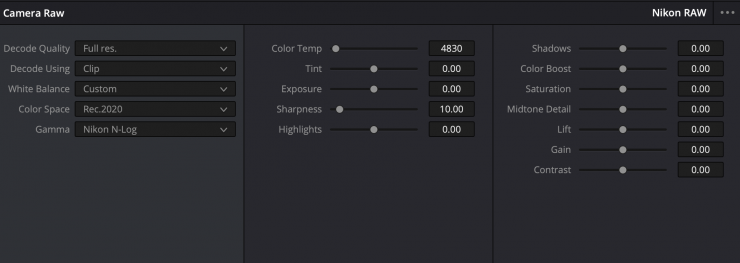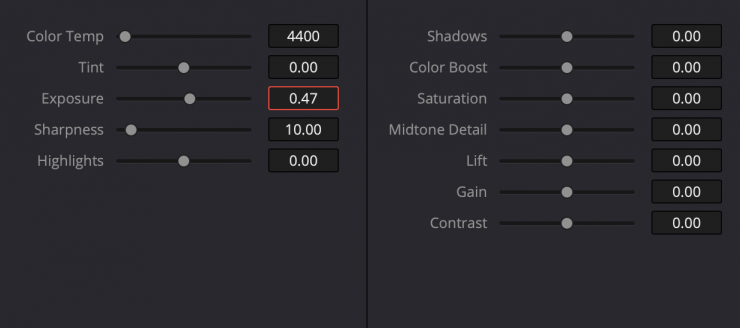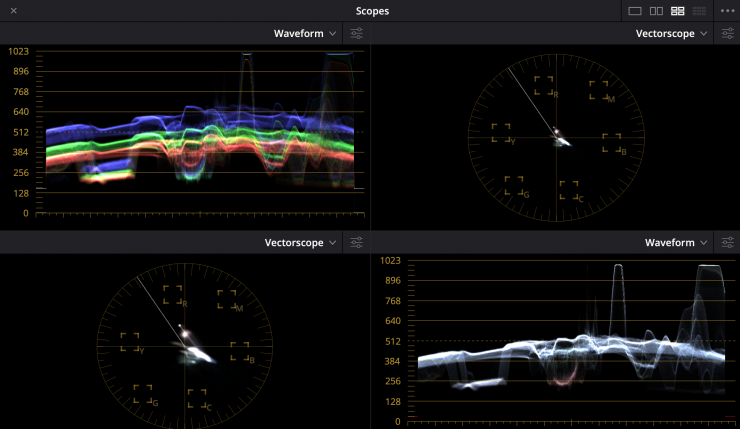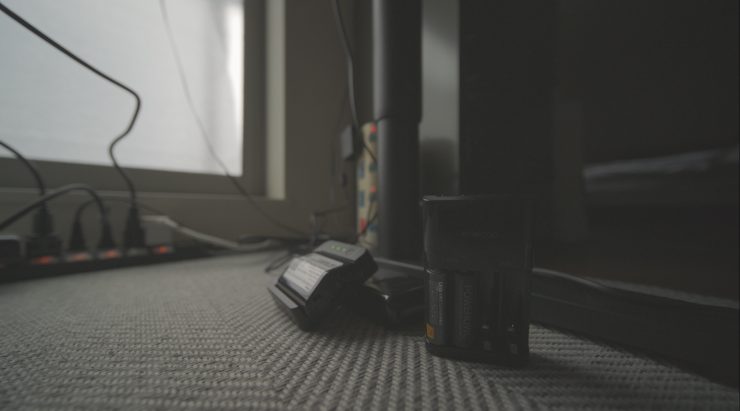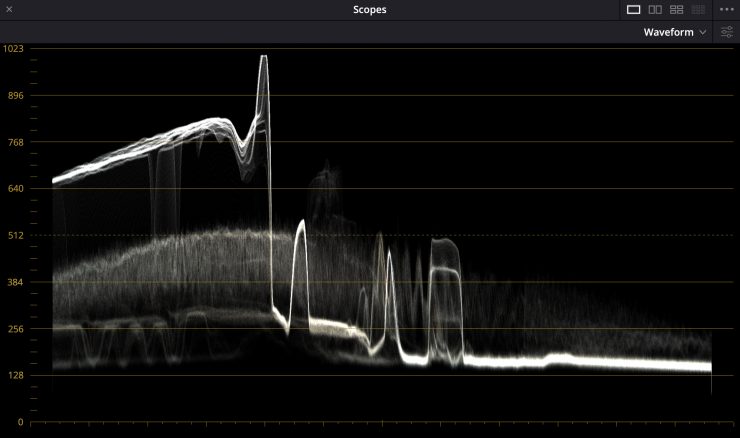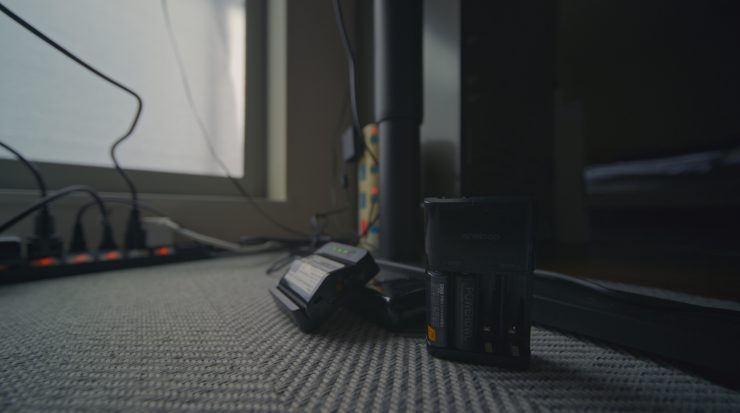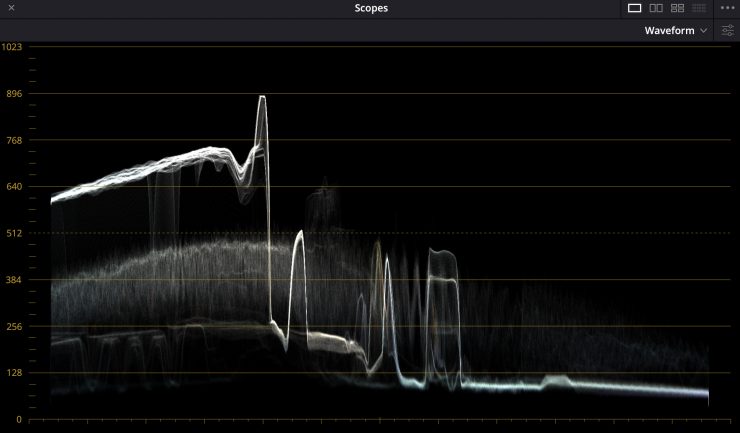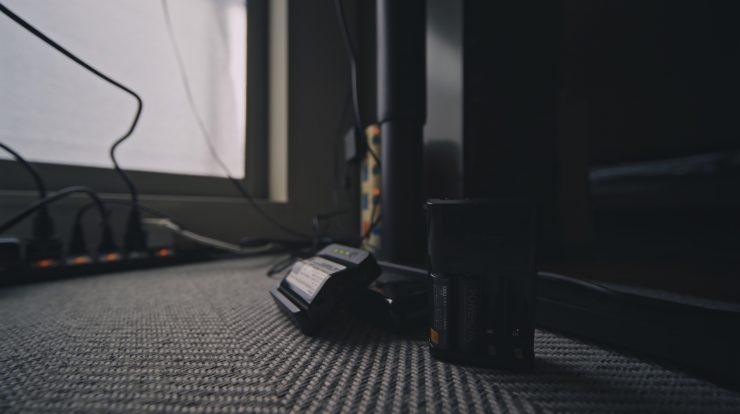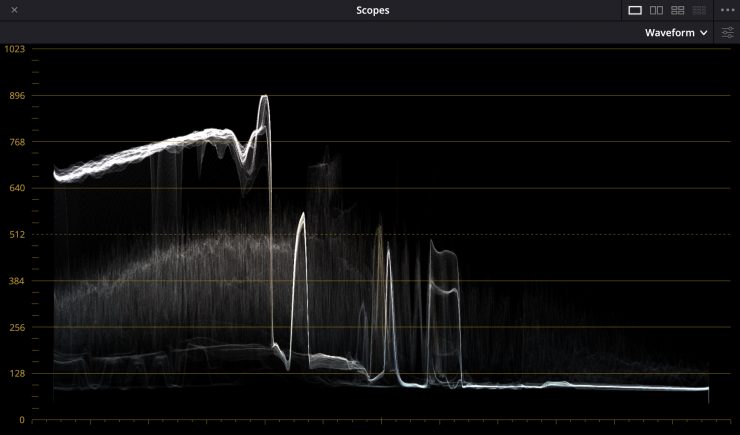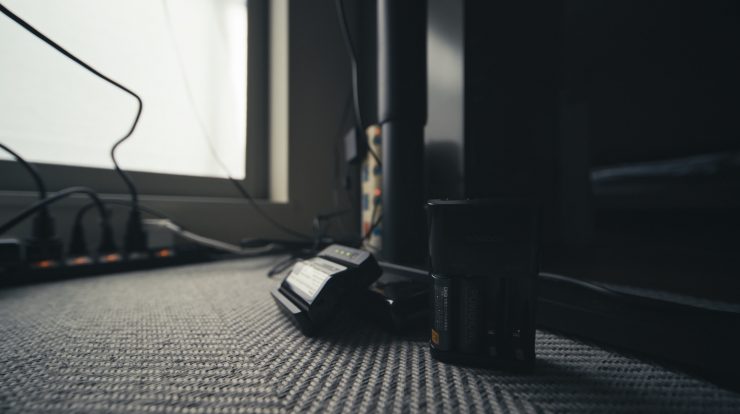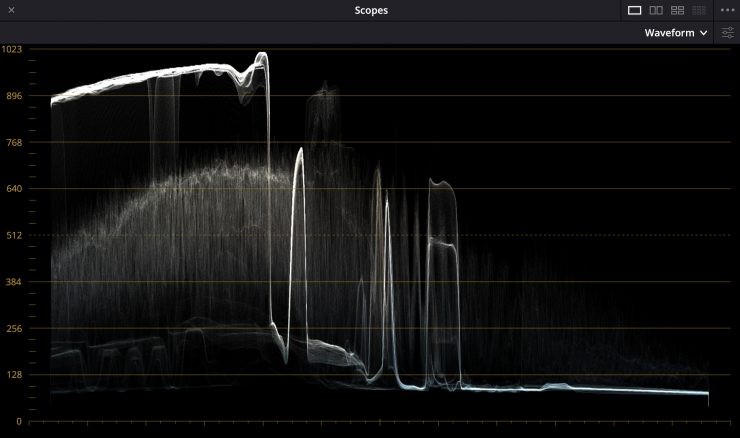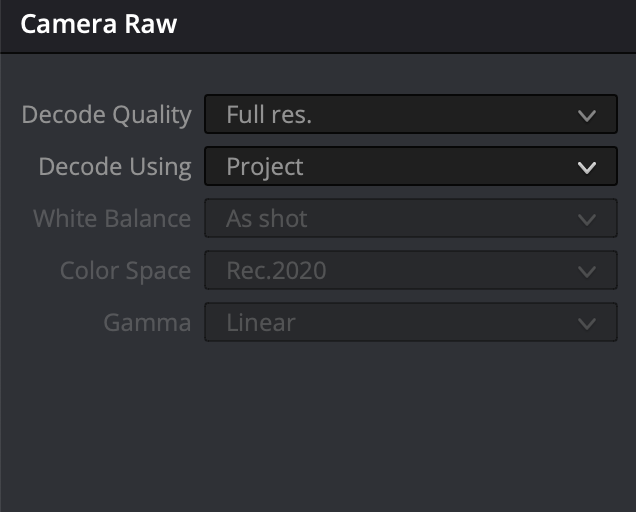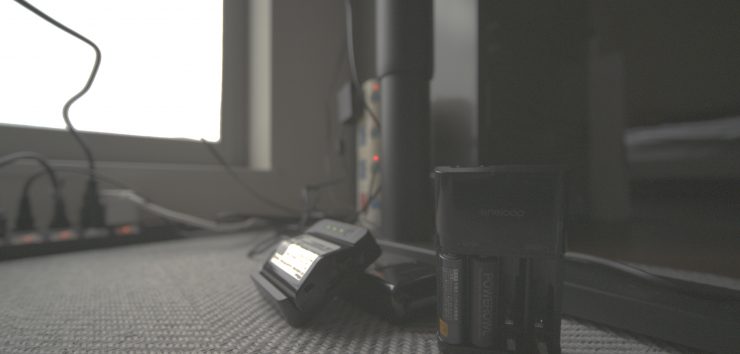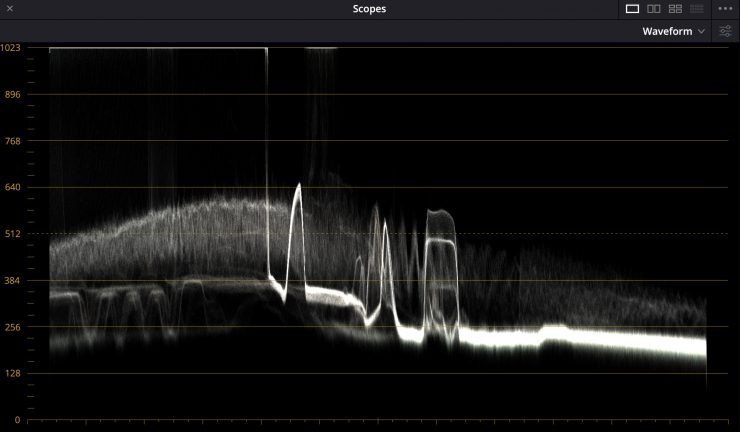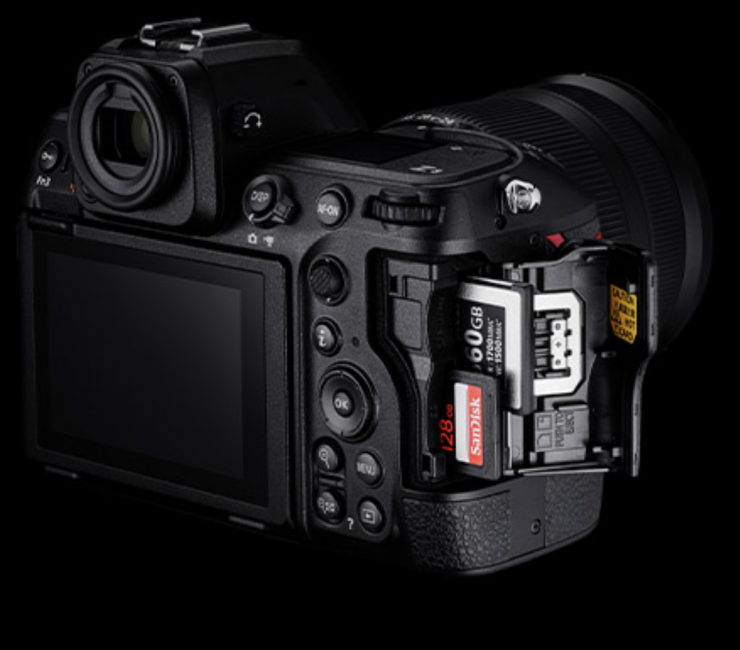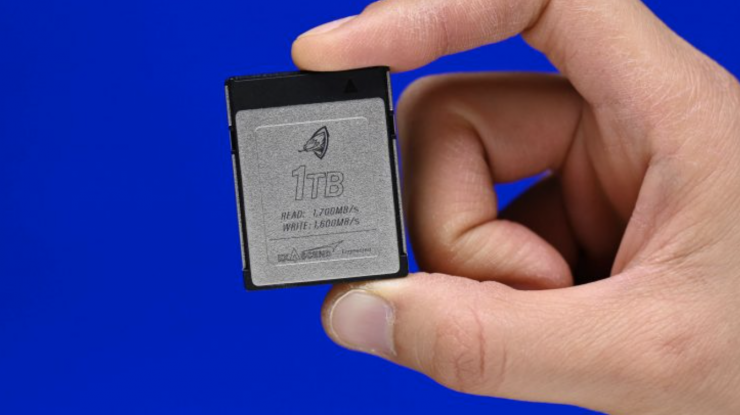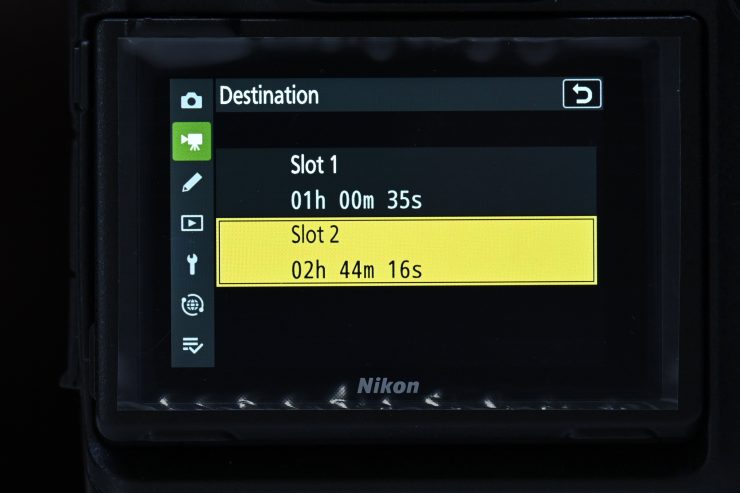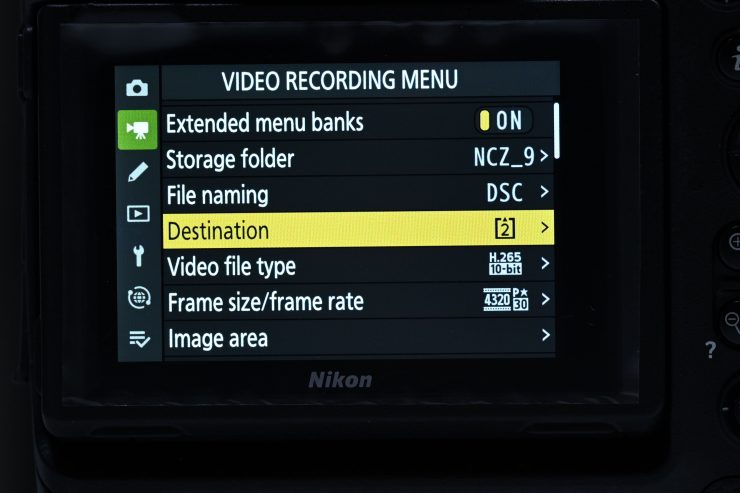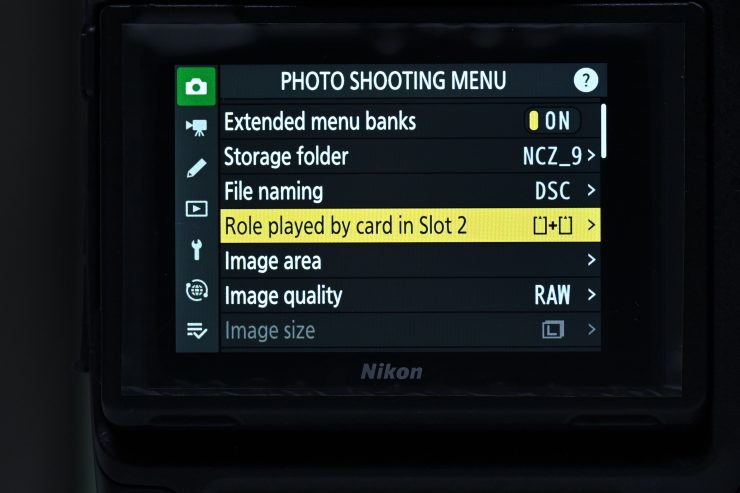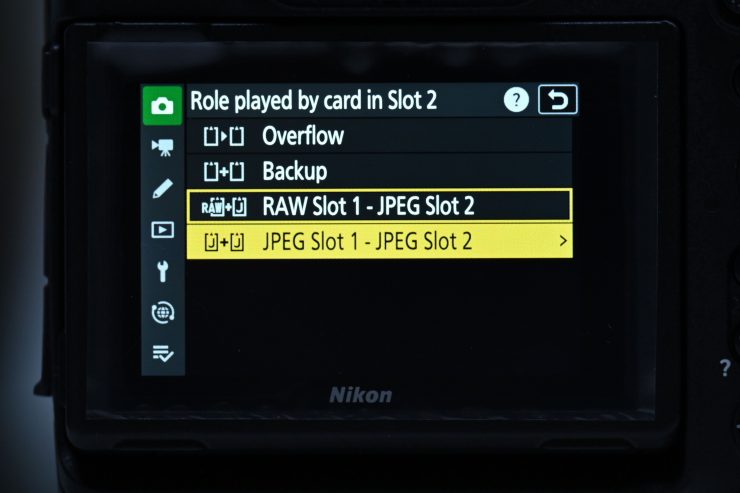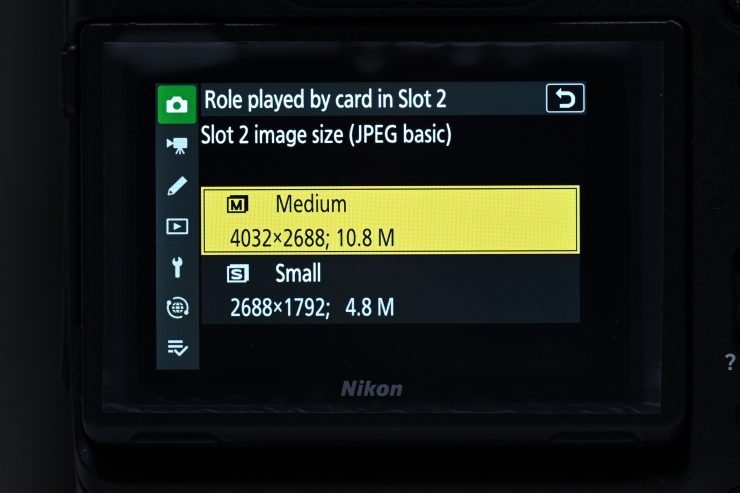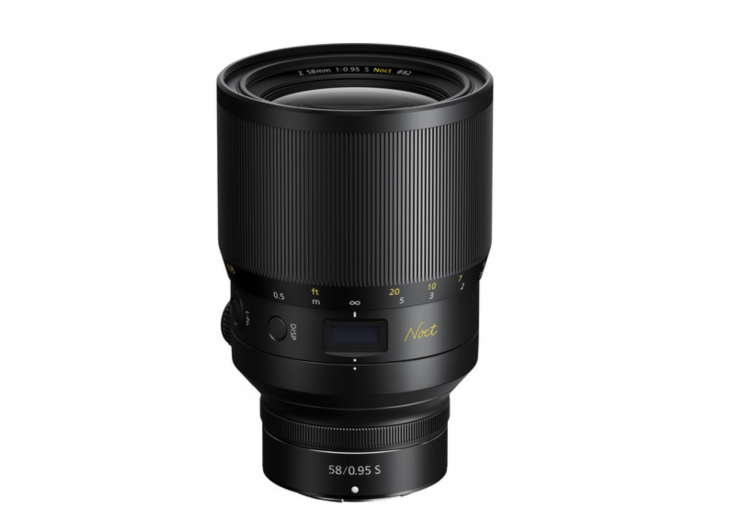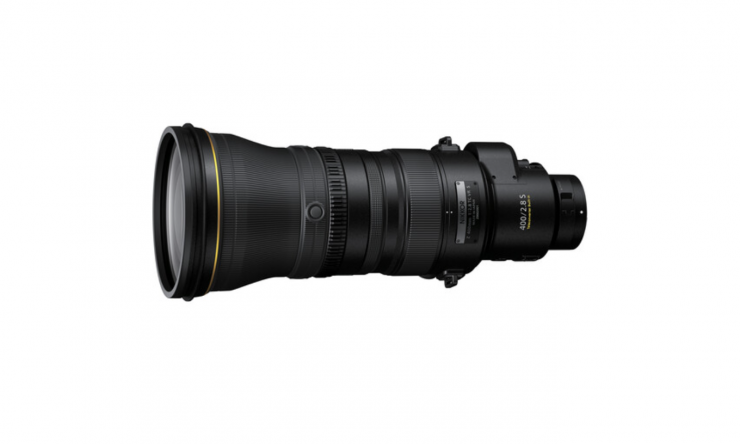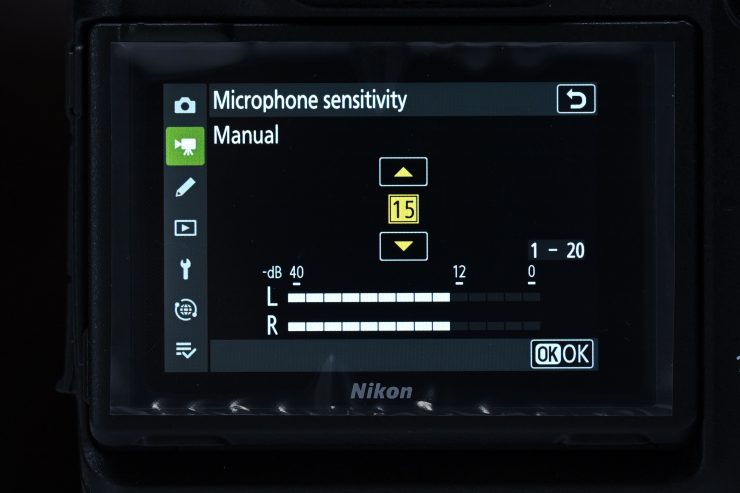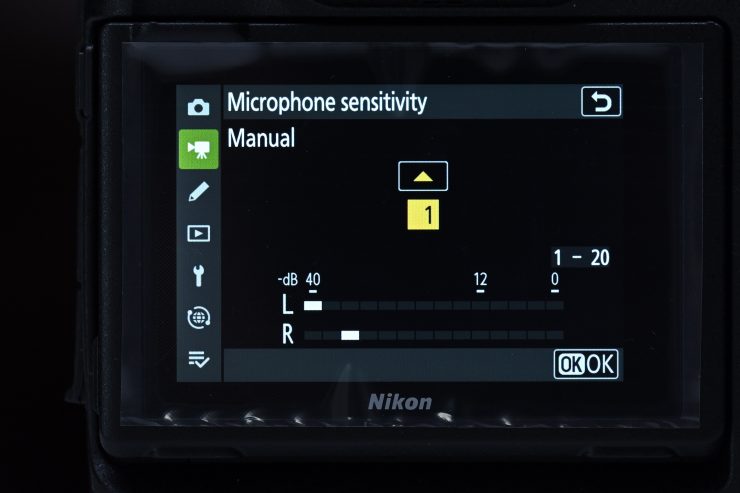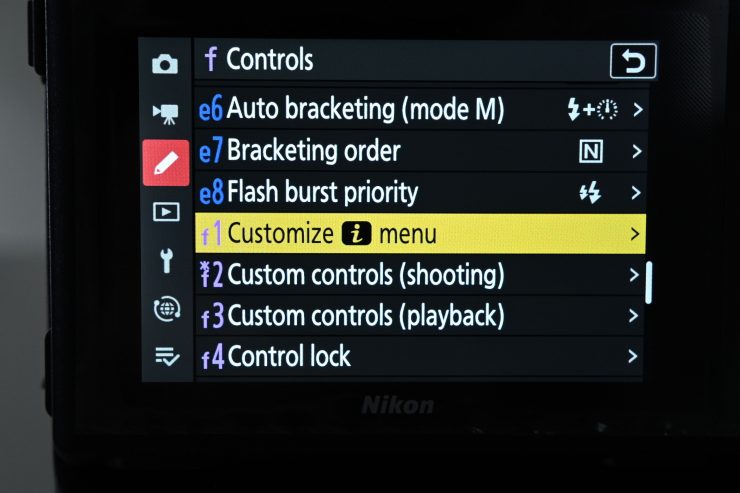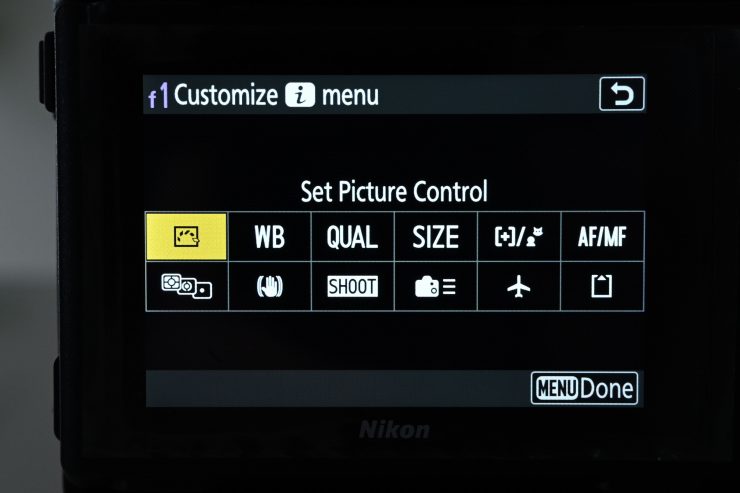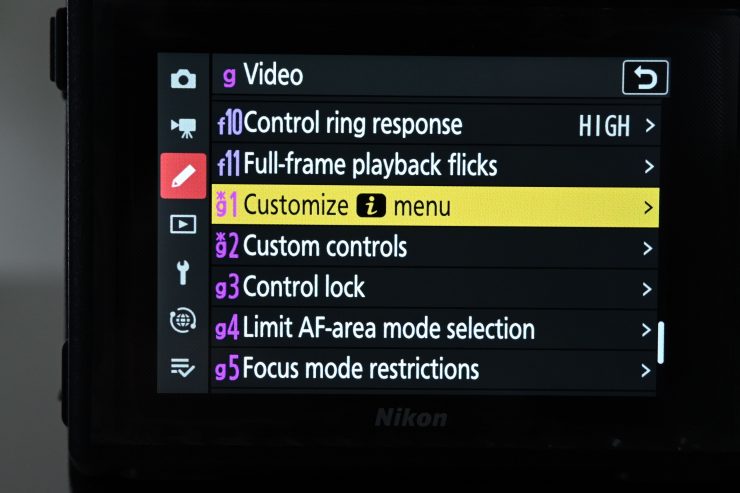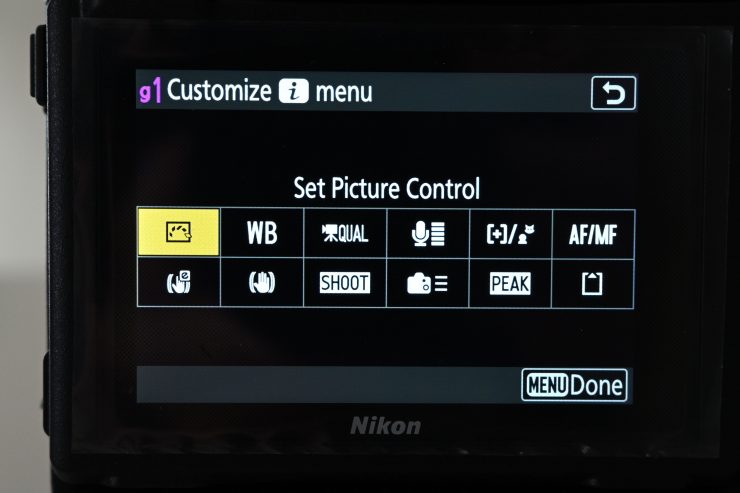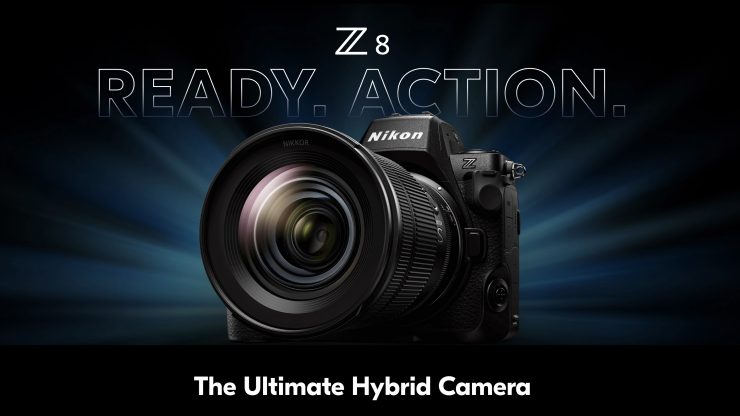
Nikon has announced its new Z8 mirrorless hybrid which was designed to fit into the lineup between the Z7 Mark II and their flagship Z9.
In a lot of ways, the Z8 is a Z9 on a diet at a lower price.
Key features
- 45.7MP Full-Frame Stacked CMOS Sensor
- EXPEED 7 Image Processor
- Smaller and Lighter than Both the Z9 and D850 Cameras
- Intelligent Tracking and Autofocusing
- 8K60p and 4K 120p Video Recording
- Internal 10-Bit ProRes 422 HQ and 12-Bit Raw
- Blackout-Free Viewfinder and 4-Axis Tilting Monitor
- Dual Memory Card Slots, Dual USB-C Ports
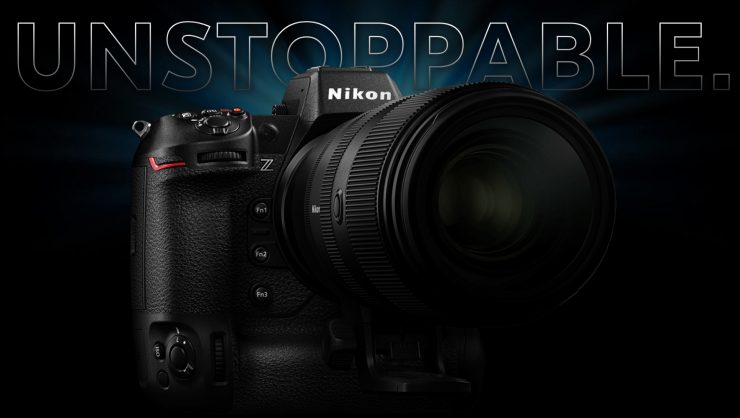
In October 2021 Nikon announced its flagship hybrid mirrorless, the Z9. The headline specifications were that it could record 8K 60p RAW internally, 8K up to 30p internally, 4K UHD ProRes 422HQ up to 60p, and it didn’t have any overheating issues.
The new Z8 packs in a lot of the same features and functionality as the Z9 which certainly does make it an interesting proposition for anyone who needs to shoot a mix of video and stills.
Swing for the fences
The Z9 arguably shocked a lot of people when it was first announced, especially because of its video capabilities. Unlike Sony, Canon, and Panasonic, Nikon doesn’t have any digital cinema cameras to protect so they are able to swing for the fences without having to worry about one camera stepping on another’s toes.
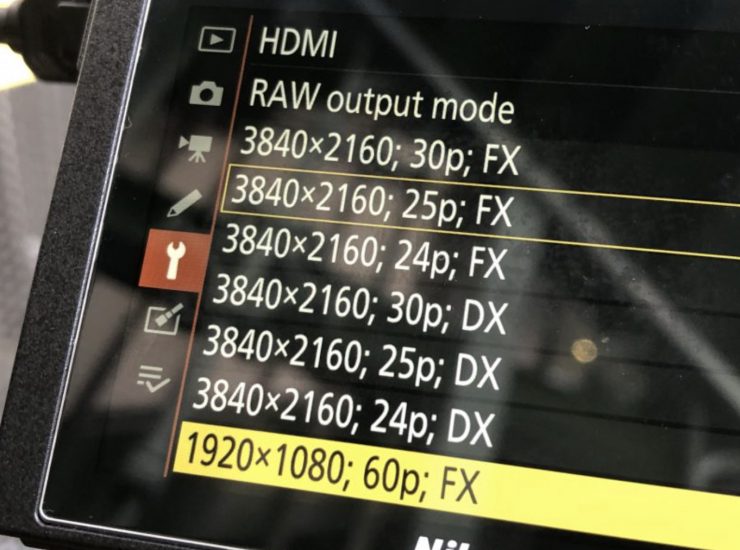
In theory, this should allow them to offer video features and functionality that others can’t. Why Nikon didn’t do this a long time ago is still a mystery to me. The release of the Nikon Z6 and Z7 would have been a perfect time to swing for the fences with video functionality. Unfortunately, Nikon chose to bunt instead and that arguably cost them a ton of potential sales. Yes, the Z6 and Z7 were the first mirrorless hybrid cameras capable of outputting a RAW signal over HDMI, but the implementation of that was poorly done, and to make matters worse, you had to send your camera to Nikon and pay money to have it enabled.
For a long time, Nikon hasn’t even been in the conversation when it comes to talking about what mirrorless hybrid you could buy if you primarily wanted a camera for shooting video. That has now all changed with the Z9 and now the Z8.
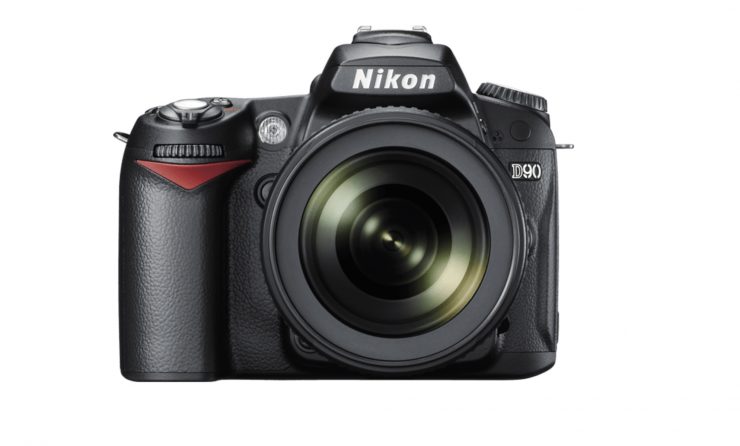
People tend to forget that it was actually Nikon, and not Canon, who first introduced video recording in a DSLR. The Nikon D90 could record 23.98p movie clips with sound at up to 720p HD (1280 x 720 pixels) in Motion JPEG for a maximum of 5 minutes. The trouble was that Canon saw the opportunity with video recording in a DSLR and ran with it, while Nikon didn’t.
Times have changed
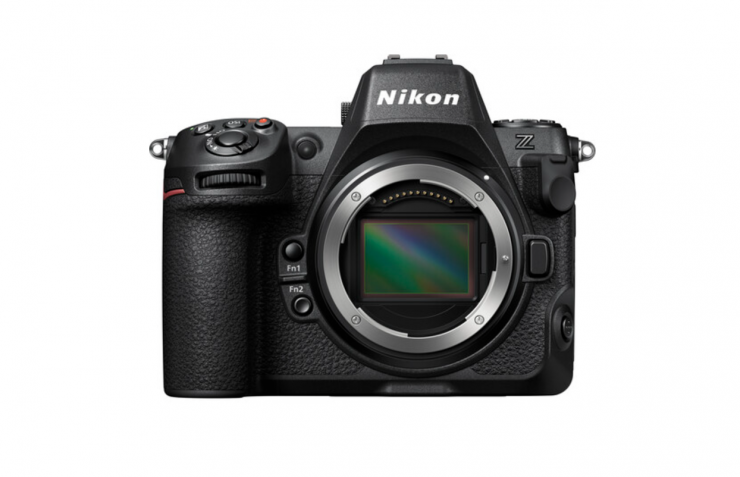
Despite the release of the Z8, Nikon still finds itself in a difficult position because a lot of potential buyers are already heavily invested in systems from Canon, Sony, and to a lesser extent Panasonic. Trying to get users of other systems to switch is an extremely hard task. A lot of shooters base their camera buying on what lenses they happen to own. Once someone is invested in a particular lens mount from a brand it is very hard to tempt them to go elsewhere unless they are using non-native lenses with an adapter. I don’t like investing in native lenses for video for this exact reason. Almost all of the glass I own can be moved around to different camera systems. This gives me increased flexibility, although this tactic isn’t going to be for everyone.
Sensor
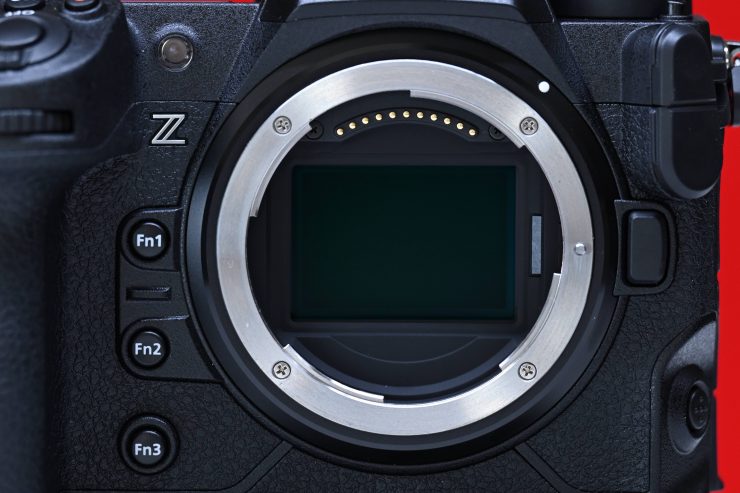
The Z8 appears to be using the exact same sensor as its bigger brother the Z9. This is an FX-format 45.7MP BSI stacked CMOS CMOS sensor with a physical size of 35.9 mm x 23.9 mm. As you would expect, this is actually a Sony sensor.
The stacked design offers fast readout speeds and helps to reduce rolling shutter, and the BSI design is claimed to contribute to impressive clarity and minimal noise when working at higher sensitivities. At 45.7MP, it’s also a high-resolution chip that benefits landscape, portraiture, and other detail-oriented genres, as well as enables recording video at resolutions up to 8K. The sensor offers a native ISO 64-25600 range, that can be expanded to ISO 32-102400.
EXPEED 7 Image Processor
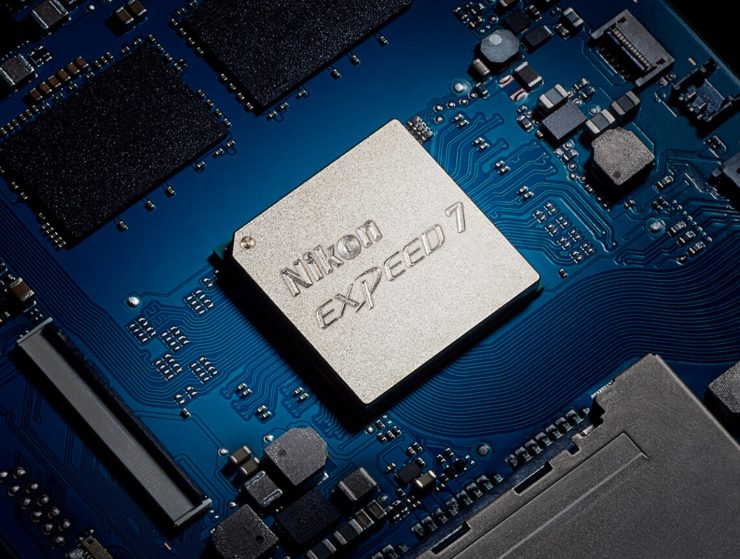
Complementing the sensor is the EXPEED 7 processing engine, which offers speeds that are claimed to be approximately 10x faster than a Z 7II. Again, this is the same processor used in the Z9. This engine works in conjunction with the stacked sensor for fast AF speeds, high burst shooting rates, a high buffer capacity, and good video performance.
A stacked sensor design reduces rolling shutter distortion so fast-moving subjects, like a golf club, tennis racket, or baseball bat, do not appear distorted when working with shutter speeds up to 1/32,000 sec.
AF calculations are done at a 120 fps rate to keep up with fast continuous shooting speeds.
The Z8 outputs two data streams from the stacked CMOS sensor: one for writing to the memory card and one for viewing. The viewing stream is unaffected by any capture processing, leaving a lag-free, uninterrupted view with absolutely no blackout.
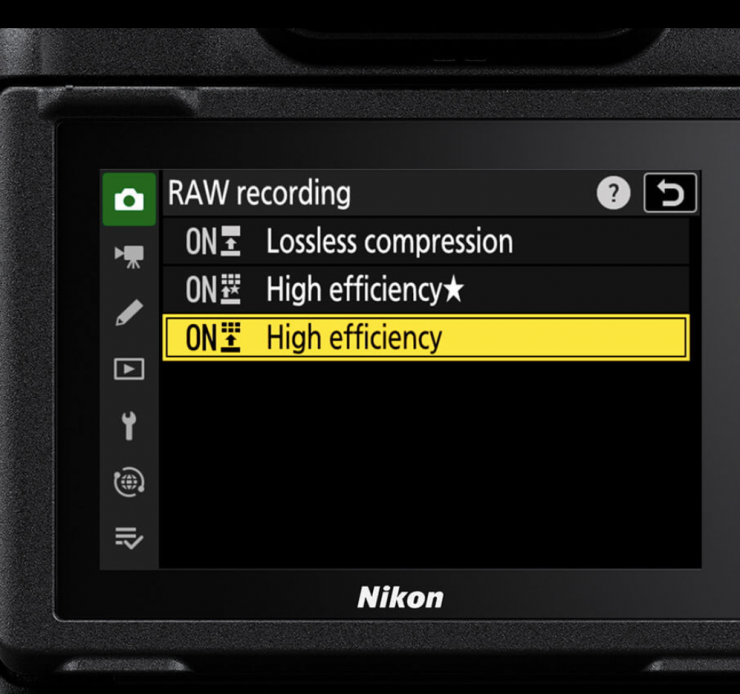
The High Efficiency RAW file format maintains image quality akin to uncompressed raw files but with file sizes approximately 30% smaller for faster reading/writing to the memory card.
Size & Weight
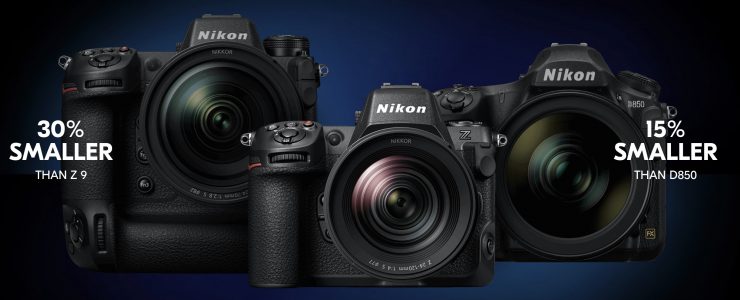
The Z8 weighs 2.0 lb / 910 g (With Battery, Recording Media).
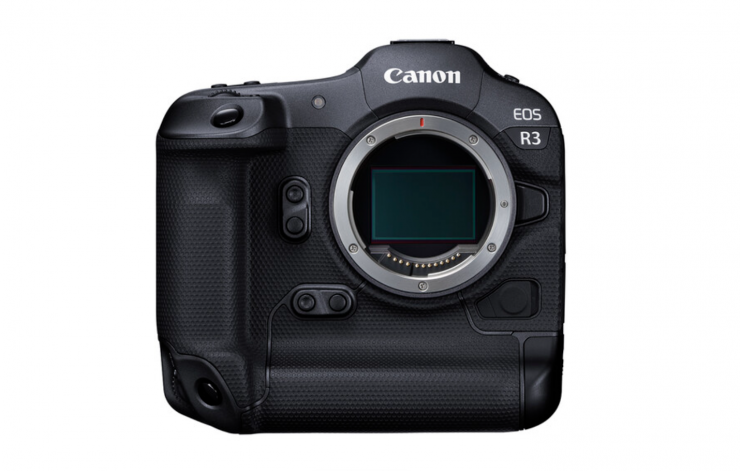
So how does this weight of the Z8 compare to offerings from Sony, Canon, and Panasonic? Below you can see:
| WEIGHT | |
| Nikon Z9 | 1160 g / 2.6 lb (Body Only) |
| Panasonic GH6 | 739g / 1.63 lb (Body only) |
| Panasonic S5 II | 658 g / 1.45 lb (Body Only) |
| Panasonic S1H | 1164 g / 2.56 lb / (Body with Battery and Memory) |
| Sony a7s III | 614 g / 1.35 lb (Body Only) |
| Sony a1 | 737 g / 1.6 lb (Body Only) |
| Sony a7 IV | 658 g / 1.4 lb (Body with Battery and Memory) |
| Sony a7R V | 723 g / 1.6 lb (With Battery, Recording Media) |
| Canon EOS R5 | 660 g / 1.45 lb (Body with Battery and Memory) |
| Canon R5 C | 680 g / 1.5 lb (Body Only) |
| Canon EOS R3 | 822 g / 1.8 lb (Body Only) |
| Nikon Z7 II | 615 g / 1.4 lb (Body Only) |
Videocentric?
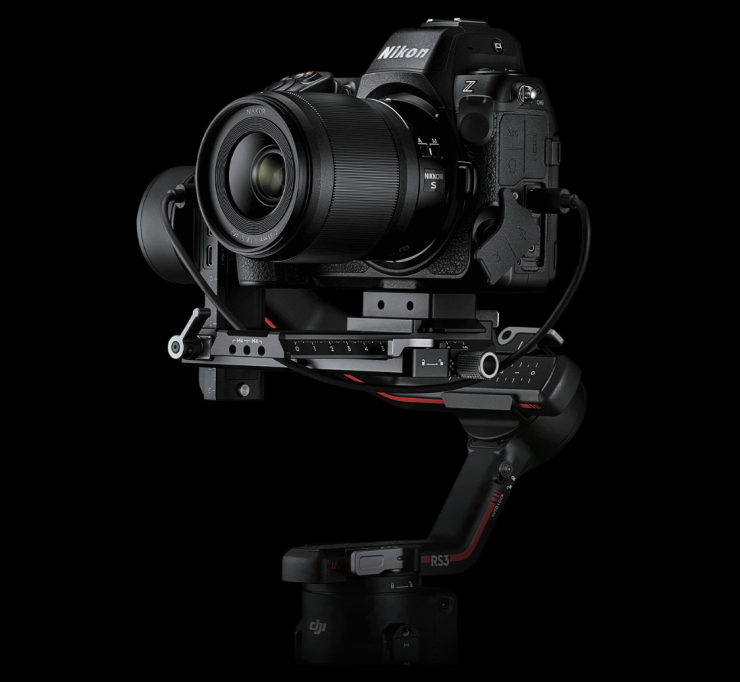
Almost all hybrid mirrorless cameras that are being released these days have impressive video specifications. Nikon has never really pushed video functionality as one of the main selling points of its mirrorless cameras until the Z9 came along. The Z8 follows in the footsteps of the Z9.
As I mentioned earlier, Nikon was the first company to introduce video recording in a full-frame DSLR camera. They were also the first to have a mirrorless camera that was capable of outputting a RAW signal over HDMI that could be recorded as ProRes RAW.
At least, in my opinion, and this may sound controversial, the Z8 isn’t what I would consider a videocentric mirrorless hybrid. Why do I say that? Well, first and foremost it is more of a high-end flagship stills camera. Yes, it has impressive video specifications, however, it isn’t like a Panasonic S1H, Canon R5 C, or Panasonic GH6 which were all specifically designed with video shooters in mind.
I also think that the Z8 is lacking quite a lot of video assist features, it has basic audio capabilities, and it has no physical timecode In/Out. That’s not to say it isn’t a capable video solution, it is just that I personally think there are more video-centric options available.
Wide range of recording formats to choose from
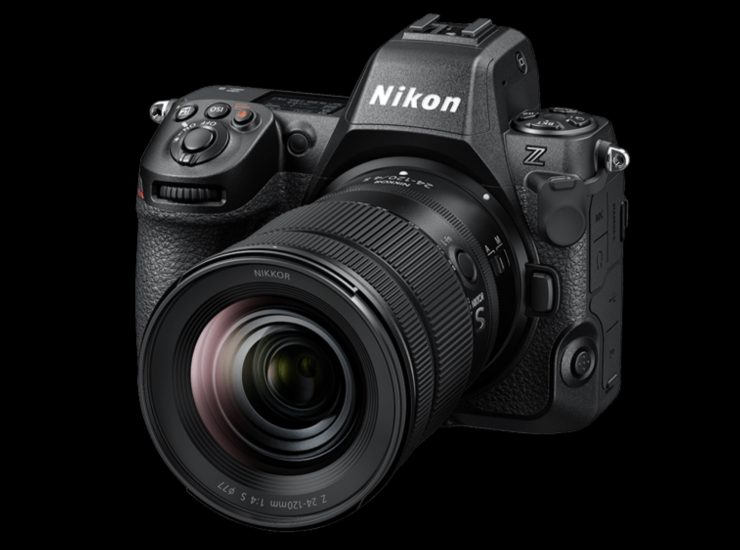
One of the biggest appeals of the Nikon Z8 is that it can shoot in a wide array of codecs, resolutions, and frame rates. Being able to choose between recording in ProRes, H.265 4:2:2 10-bit, ProRes RAW and N-RAW gives this camera ton of flexibility.
Internal ProRes Recording
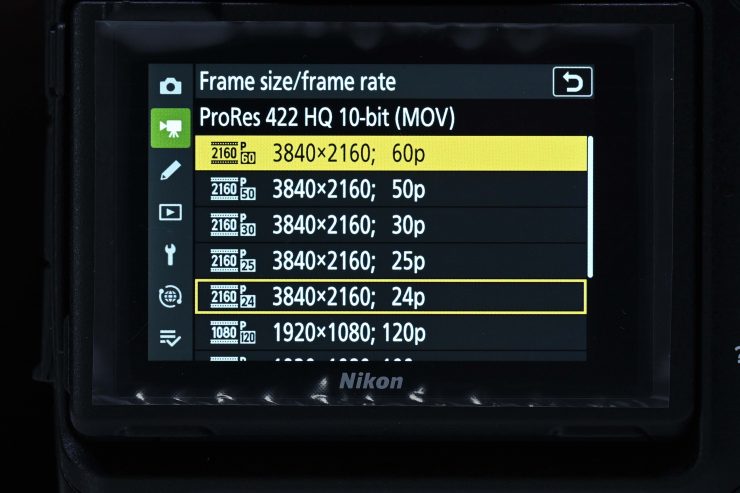
The Z9 was the first hybrid mirrorless camera that was able to record internally in ProRes 422 HQ, and the Z8 follows suit.
Yes, ProRes files do take up considerably more space than say an H.265 codec, but they are vastly easier to use and deal with in post. My primary cameras all record internally in ProRes so having another camera that can also do the same helps in my workflow.
The big benefits of ProRes files is that not only are they very robust, but they are also super easy to deal with.
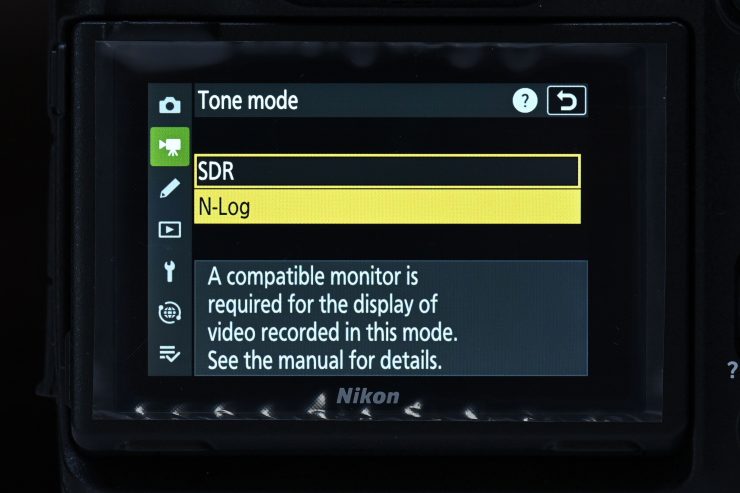
When you are in ProRes you can choose either SDR or N-Log.
Now, there is a caveat when recording in ProRes. You are limited to capturing in resolutions of 4K UHD or HD, you can’t record 8K ProRes. In saying that, I don’t know how many people would want to record in 8K ProRes as the data rates would be ridiculously big and the amount of recording time you would get on a 1TB card would be very limited.
Internal Recording Options
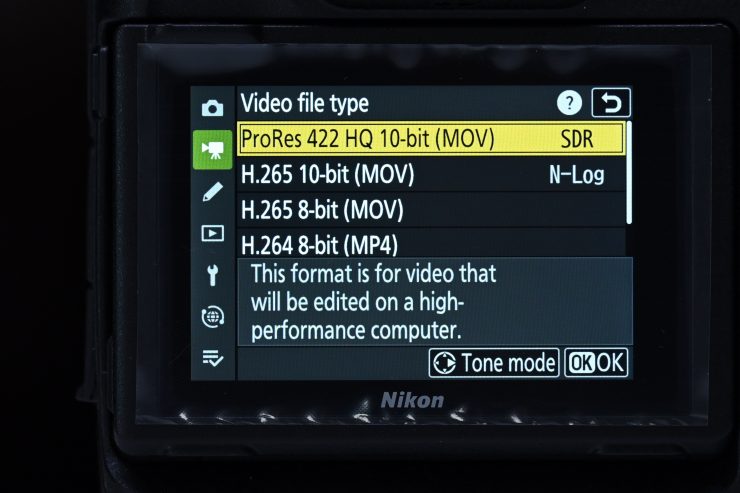
Nikon gives you the choice of internally recording in five different formats:
- MP4
- MOV
- ProRes
- N-RAW
- ProRes RAW
What is nice is that the Z8 can record every resolution and frame rate in 4:2:2 10-bit. There are no gotchas where certain frame rates or options can only be recorded in 4:2:0 10-bit or 8-bit codecs.
Now, according to Nikon the Z8 can record 10-bit 4K UHD footage in-camera with full pixel readout at 23.98, 25, 29.97p as ProRes 422 HQ or H.265 video. You can now do 4K UHD at up to 60p with a full sensor readout. By turning this on it optimizes image readout for improved image quality when you are shooting 3840×2160 60p or 3840×2160; 50p. I am not sure why you would want to turn this setting off! This in theory should provide way better results than the sub-sampled 4K UHD 60p material. The only slight caveat when using this mode is that the battery will drain faster.
I will talk about N-RAW and ProRes RAW in a lot more detail further down in the article.
Here is what the Z8 can capture when it comes to internal video recording:
ProRes
| RESOLUTION | BIT DEPTH | FRAME RATE | DATA RATE |
| 4K UHD (3840 x 2160) | ProRes 422 HQ 4:2:2 10-bit | 59.94p 50p 29.97p 25p 23.98p | 1768 Mb/s 1475 Mb/s 884 Mb/s 737 Mb/s 707 Mb/s |
| HD (1920 x 1080) | ProRes 422 4:2:2 10-bit | 119.88p 100p 59.94p 50p | 1010 Mb/s 842 Mb/s 440 Mb/s 367 Mb/s |
Above you can see the frame rates and data rates that are available when recording in ProRes. What you clearly need to factor in is how much data you are going to burn through recording 4K ProRes.
MOV H.265 4:2:2 10-bit Recording
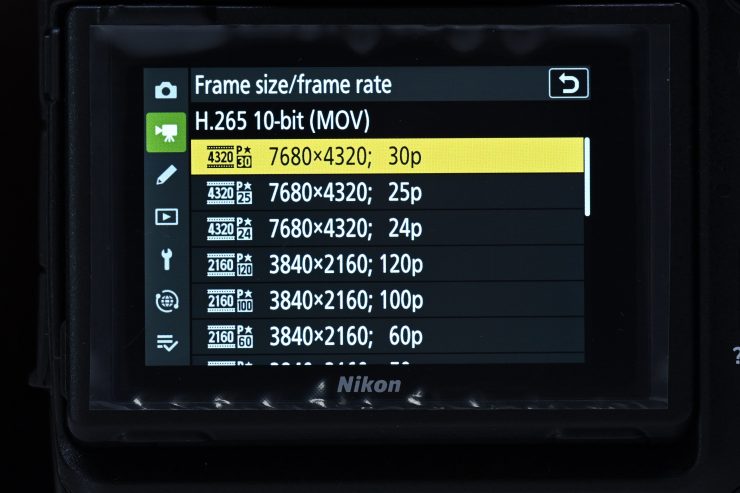
You also have the ability to record in H.265 in 4:2:2 10-bit.
| RESOLUTION | BIT DEPTH | FRAME RATE | DATA RATE |
| 8K UHD (7680 x4320) | H.265 4:2:2 10-bit | 23.98p 25p 29.97p | 400 Mbps 400 Mbps 400 Mbps |
| UHD (3840 x 2160) | 4:2:2 10-bit | 23.98p 25p 29.97p 50p 59.94p 100p 119.88p | 190 Mbps 190 Mbps 190 Mbps 340 Mbps 340 Mbps 400 Mbps 400 Mbps |
| HD (1920 x 1080) | 4:2:2 10-bit | 23.98p 25p 29.97p 50p 59.94p 100p 119.88p | 50 Mbps 50 Mbps 50 Mbps 100 Mbps 100 Mbps 190 Mbps 190 Mbps |
In H.265 in 4:2:2 10-bit you can record 8K UHD, 4K UHD, and HD. Having the ability to record all of the resolutions and framerates in 4:2:2 10-bit is impressive.
MOV H.265 4:2:0 8-bit Recording
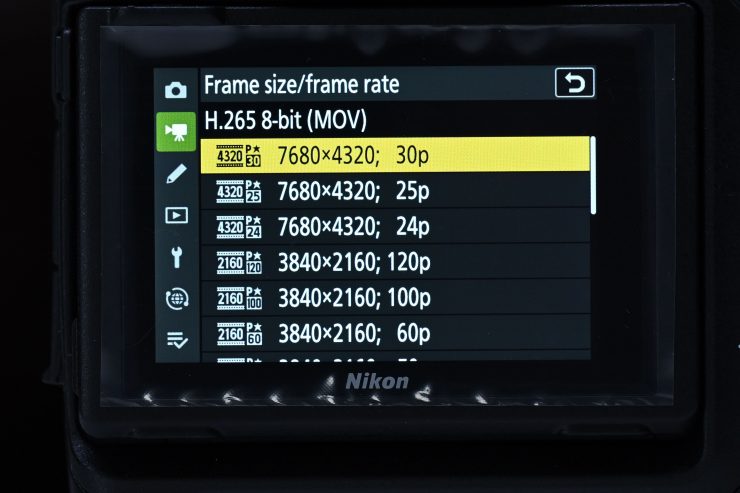
Below you can see the options available when recording H.265 4:2:0 8-bit.
| RESOLUTION | BIT DEPTH | FRAME RATE | DATA RATE |
| 8K UHD (7680 x4320) | H.265 4:2:0 8-bit | 23.98p 25p 29.97p | 370 Mbps 370 Mbps 370 Mbps |
| UHD (3840 x 2160) | H.265 4:2:0 8-bit | 23.98p 25p 29.97p 50p 59.94p 100p 119.88p | 150 Mbps 150 Mbps 150 Mbps 300 Mbps 300 Mbps 370 Mbps 370 Mbps |
| HD (1920 x 1080) | H.265 4:2:0 8-bit | 23.98p 25p 29.97p 50p 59.94p 100p 119.88p | 40 Mbps 40 Mbps 40 Mbps 80 Mbps 80 Mbps 150 Mbps 150 Mbps |
These are probably good options if you are shooting in standard picture profiles for fast turnaround and don’t want to create large file sizes.
MP4 H.264 4:2:0 8-bit
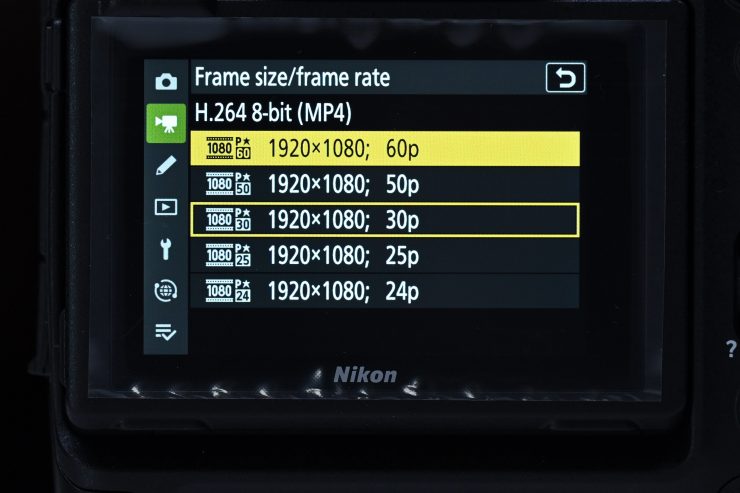
There are also MP4 H.264 4:2:0 8-bit recording options available if you need to just shoot in HD.
| RESOLUTION | BIT DEPTH | FRAME RATE | DATA RATE |
| HD (1920 x 1080) | H.264 4:2:0 8-bit | 23.98p 25p 29.97p 50p 59.94p | 200 Mbps 200 Mbps 200 Mbps 200 Mbps 200 Mbps |
No VFR & No 8K /4K DCI Options
The Nikon Z8 can’t record in 8K DCI or 4K DCI, nor does it have any way of capturing variable frame rates.
If you are also required to shoot in interlace, you are out of luck because that is something the Z8 also can’t do.
There is no reason why 8K DCI or 4K DCI options could be added through future firmware updates.
No Anamorphic Recording Options
The Z8 doesn’t have any anamorphic recording capabilities. In saying that neither does the Canon EOS R3 or the Sony a1. Some of the only cameras that can are made by Panasonic.
Recording Time Limitations
The Z8 does have a single recording limitation, but in the real world this is fairly meaningless. You can record up to 125 Minutes of UHD 8K (7680 x 4320) at 29.97p (4:2:2 10-Bit). Essentially it doesn’t matter what resolution, frame rate, or codec you are recording in, the only limitation will be how much you can fit on a single card.
| RECORDING TIME 1TB CARD | |
| 4K UHD 59.94p ProRes 422 HQ | 1 hour 6 minutes |
| 4K UHD 50p ProRes 422 HQ | 1 hour 19 minutes |
| 4K UHD 29.97p ProRes 422 HQ | 2 hours 12 minutes |
| 4K UHD 25p ProRes 422 HQ | 2 hours 38 minutes |
| 4K UHD 23.98p ProRes 422 HQ | 2 hours 44 minutes |
| HD 119.88p ProRes 422 HQ | 2 hours 12 minutes |
| HD 100p ProRes 422 HQ | 2 hours 38 minutes |
| HD 59.94p ProRes 422 HQ | 4 hours 24 minutes |
| HD 50p ProRes 422 HQ | 5 hours 15 minutes |
Above you can see how long you can record ProRes 422 HQ in various modes using a 1TB CFexpress Type B card. Being able to record 2 hours and 44 minutes of 4K UHD at 23.98p in ProRes will appeal to a lot of people.
| RECORDING TIME 1TB CARD | |
| 8K UHD 29.97p H.265 10-bit | 4 hours 43 minutes |
| 8K UHD 25p H.265 10-bit | 4 hours 43 minutes |
| 8K UHD 23.98p H.265 10-bit | 4 hours 43 minutes |
| 4K UHD 119.88p H.265 10-bit | 4 hours 43 minutes |
| 4K UHD 100p H.265 10-bit | 4 hours 43 minutes |
| 4K UHD 59.94p H.265 10-bit | 5 hours 39 minutes |
| 4K UHD 50p H.265 10-bit | 5 hours 39 minutes |
| 4K UHD 29.97p H.265 10-bit | 10 hours |
| 4K UHD 25p H.265 10-bit | 10 hours |
| 4K UHD 23.98p H.265 10-bit | 10 hours |
| HD 119.88p H.265 10-bit | 10 hours |
| HD 100p H.265 10-bit | 10 hours |
| HD 59.94p H.265 10-bit | 19 hours 54 minutes |
| HD 50p H.265 10-bit | 19 hours 54 minutes |
| HD 29.97p H.265 10-bit | 39 hours 1 minute |
| HD 25p H.265 10-bit | 39 hours 1 minute |
| HD 23.98p H.265 10-bit | 39 hours 1 minute |
Above you can see the recording times when you are using H.265 4:2:2 10-bit. As you can see you can get very long recording times on a single 1TB card in 8K, 4K, and HD.
| RECORDING TIME 1TB CARD | |
| 8K UHD 29.97p H.265 8-bit | 5 hours 8 minutes |
| 8K UHD 25p H.265 8-bit | 5 hours 8 minutes |
| 8K UHD 23.98p H.265 8-bit | 5 hours 8 minutes |
| 4K UHD 119.88p H.265 8-bit | 5 hours 8 minutes |
| 4K UHD 100p H.265 8-bit | 5 hours 8 minutes |
| 4K UHD 59.94p H.265 8-bit | 6 hours 16 minutes |
| 4K UHD 50p H.265 8-bit | 6 hours 16 minutes |
| 4K UHD 29.97p H.265 8-bit | 12 hours 28 minutes |
| 4K UHD 25p H.265 8-bit | 12 hours 28 minutes |
| 4K UHD 23.98p H.265 8-bit | 12 hours 28 minutes |
| HD 119.88p H.265 8-bit | 12 hours 28 minutes |
| HD 100p H.265 8-bit | 12 hours 28 minutes |
| HD 59.94p H.265 8-bit | 24 hours 38 minutes |
| HD 50p H.265 8-bit | 24 hours 38 minutes |
| HD 29.97p H.265 8-bit | 48 hours 5 minutes |
| HD 25p H.265 8-bit | 48 hours 5 minutes |
| HD 23.98p H.265 8-bit | 48 hours 5 minutes |
Above you can see how long you can record for on a 1TB card when choosing H.265 4:2:0 8-bit. It is crazy to think if you had two 1TB cards in the camera and you only had to record HD 23.98p you could get 96 hours and 10 minutes of record time without needing to change out a card. If you were working in a war zone or hostile environment having the ability to record for long periods of time without needing to change media helps a lot.
| RECORDING TIME 1TB CARD | |
| HD 59.94p H.264 8-bit | 40 hours 24 minutes |
| HD 50p H.264 8-bit | 40 hours 24 minutes |
| HD 29.97p H.265 8-bit | 80 hours 22 minutes |
| HD 25p H.264 8-bit | 80 hours 22 minutes |
| HD 23.98p H.265 8-bit | 80 hours 22 minutes |
Above you can see how long you can record H.264 4:2:0 8-bit on a 1TB card. Having an H.264 4:2:0 8-bit option makes a lot of sense for professional photographers who also have to capture some video on the side. These smaller-sized HD files are easy to transmit over WiFi, ethernet or 4G/5G.
DX & 2.3x Crop Formats
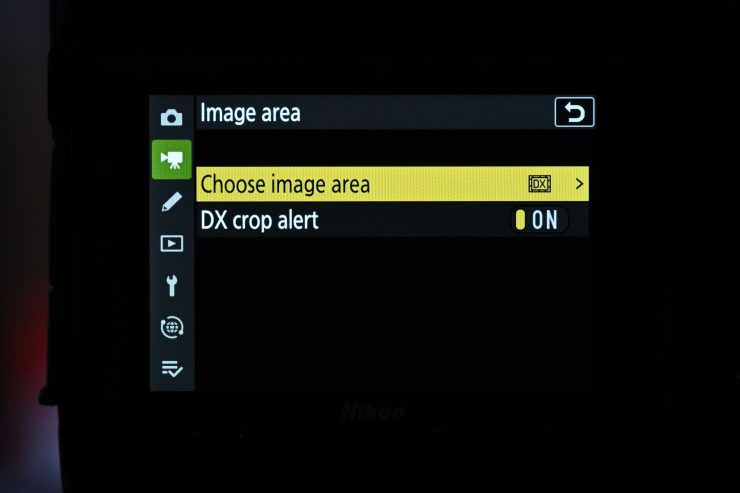
When you are recording video in resolutions of 4K UHD or lower you can select a DX crop format This is done with a full pixel readout and it allows you to drastically increase your focal range without changing lenses.

Now, the way Nikon has set up the DX and 2.3x crop can be a little confusing. When you are shooting in 4K UHD or HD at frame rates of up to 59.94p and you select DX mode you get a regular Super35 style crop. If you are shooting in 4K UHD or HD at 100p and above and you select DX mode, you are actually in a 2.3x DX crop mode.
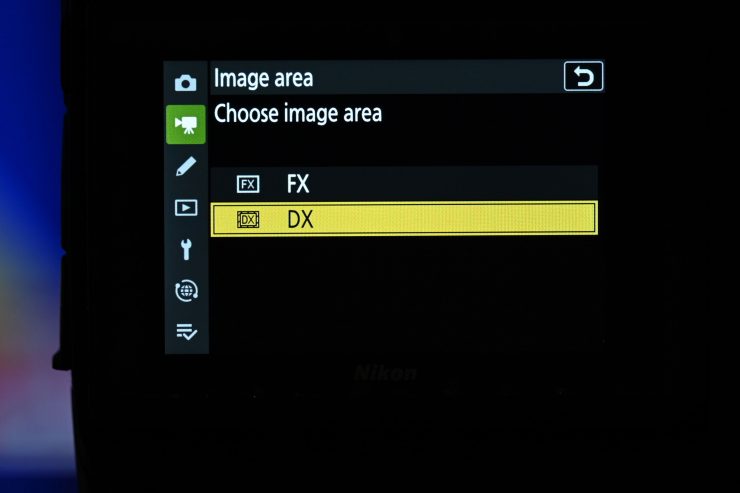
The DX mode is the equivalent of a 1.51x crop.
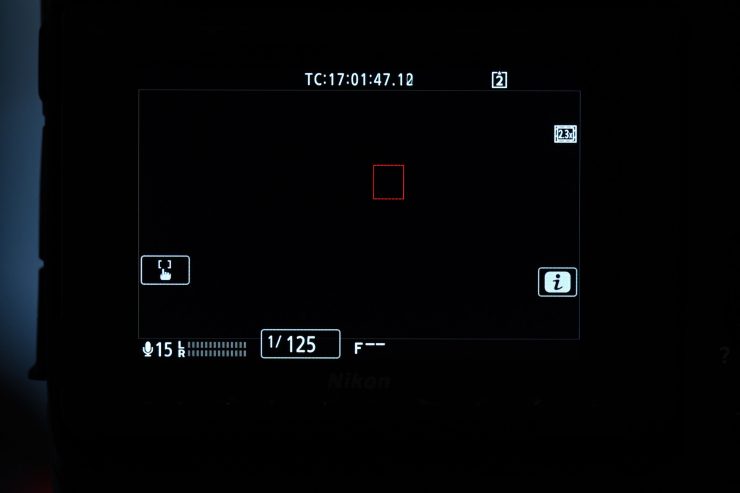
Nikon gives you the ability to turn On a DX crop warning indicator that flashes on your screen so that you are fully aware that you are using the mode.
N-RAW
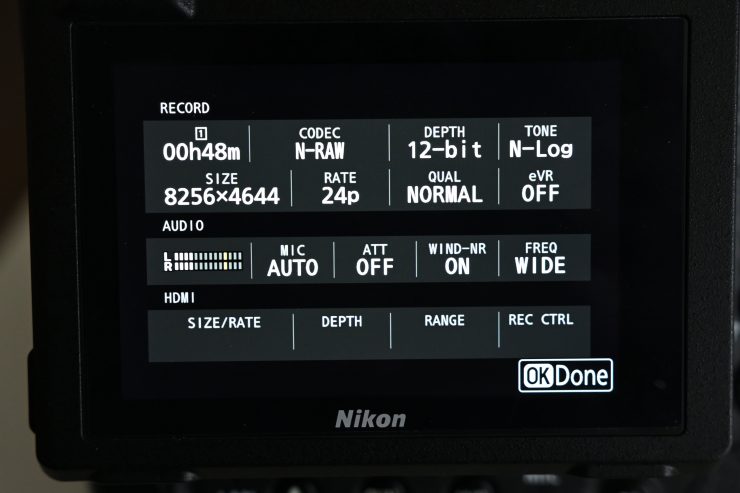
The Z8 can now record 8.3K (8256 x 4644) 60p in Nikon’s N-RAW format or up to 4.1K 60p in ProRes RAW HQ. According to Nikon, this allows the Z8 to capture the largest possible color depth and a vast dynamic range for maximum flexibility when color grading and in post-production.
Nikon’s N-RAW (.NEV file) produces a 12-bit RAW video file that’s half the size of equivalent ProRes RAW HQ files. The whole aim of N-RAW is to create smaller file sizes so users can record for longer periods of time as well as have fewer data-intensive files to work with in post.
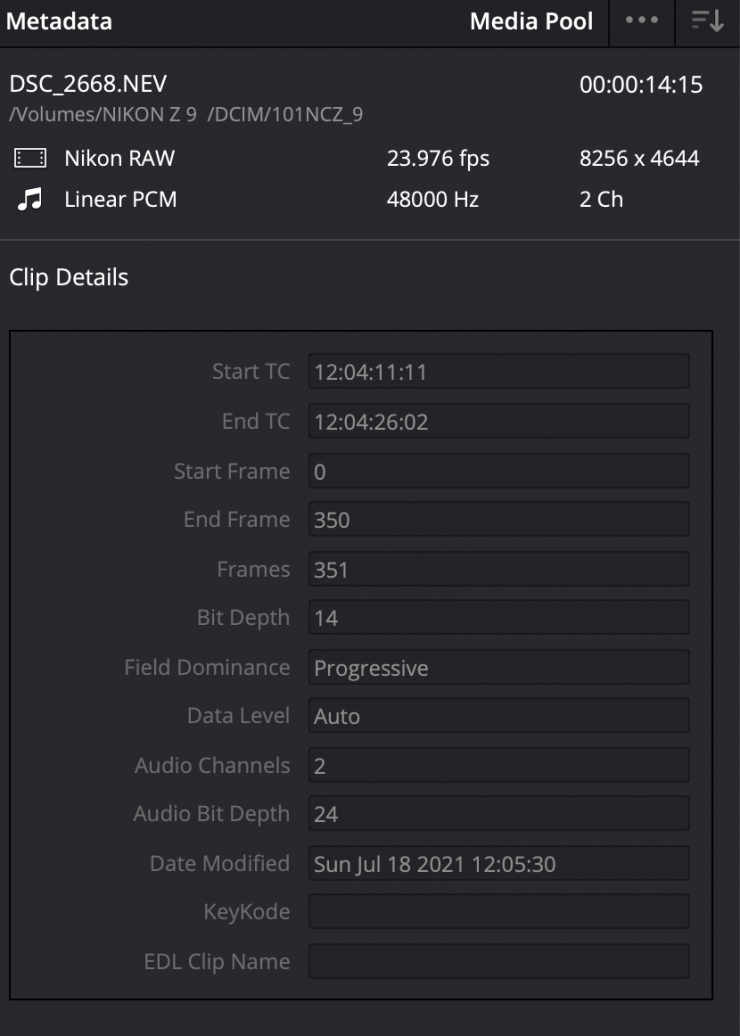
Strangely DaVinci Resolve shows N-RAW as being 14-bit and not 12-bit but I have a feeling it is simply just displaying the linear RAW value and not the Log value.
N-RAW footage can be recorded in the following formats:
Full Frame/FX Mode
- 8.3K 60p
- 8.3K 50p
- 8.3K 25p
- 8.3K 24p
- 4.1K 120p
- 4.1K 100p
- 4.1K 60p
- 4.1K 50p
- 4.1K 30p
- 4.1K 25p
- 4.1K 24p
2.3x Crop
- 3.8K 120p
- 3.8K 100p
1.5x DX Crop
- 5.4K 60p
- 5.4K 50p
- 5.4K 30p
- 5.4K 25p
- 5.4K 24p
What is nice is that when you record N-RAW it also creates an mp4 proxy file. You don’t have to select this in a menu, it automatically creates the proxy file as soon as N-RAW is selected.
In N-RAW you have a choice of two-tone modes: SDR and N-Log. This is quite unusual for a RAW format. If you choose SDR you have access to various picture profiles and other settings, which at least in my opinion, makes little sense when shooting RAW.
There are also two quality settings High and Normal
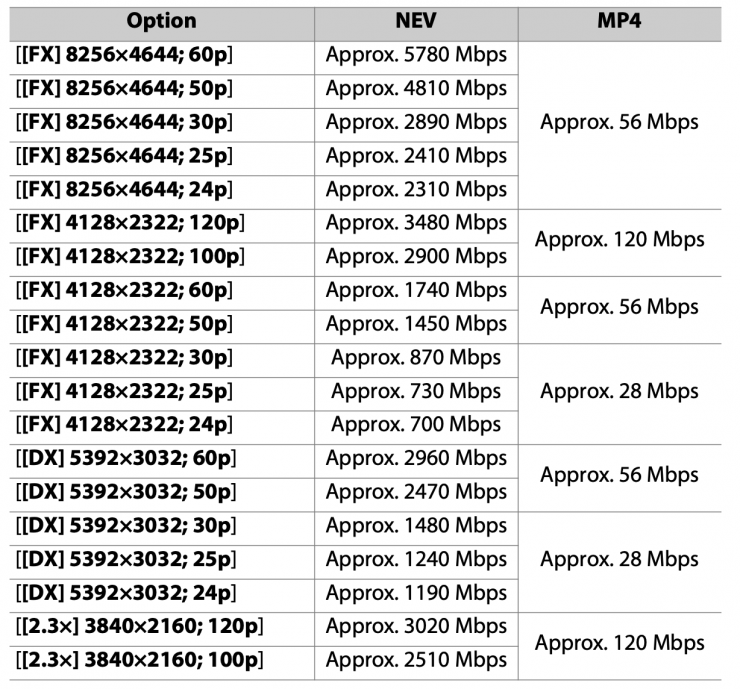
N-RAW High Quality 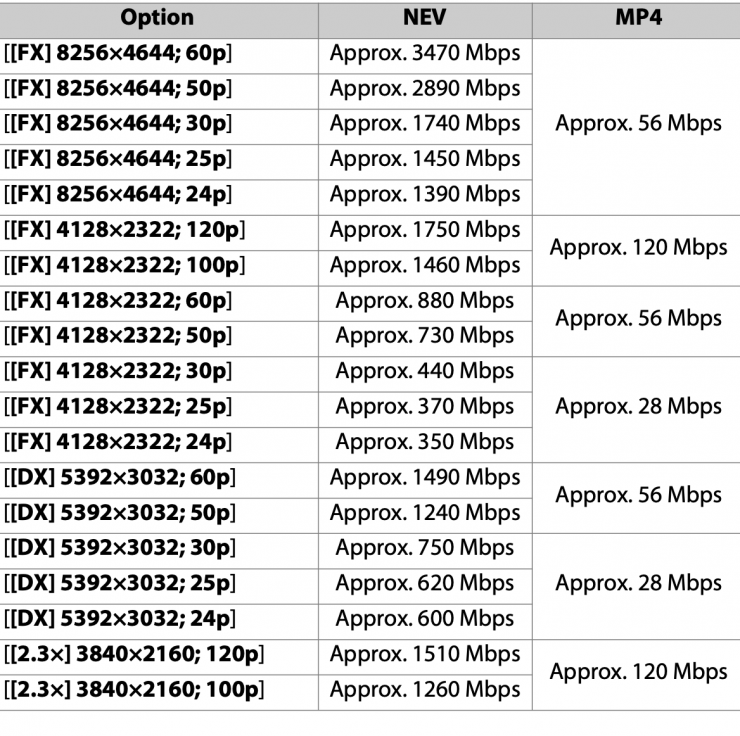
N-RAW Normal Quality
Above you can see the bitrates when recording in N-RAW High Quality and Normal. There is a fairly big difference in the recorded file sizes for these two modes. TicoRAW does have three different compression ratios, but Nikon doesn’t list what the High Quality and Normal modes are.
Despite the file sizes being fairly small for 8K RAW, a 1TB CFexpress card will let you shoot 23 minutes of 8K 60p N-RAW in the High Quality setting. If you switch to the Normal quality setting you get 38 minutes.
It is really interesting to see that the Z8, Just like the Z9 has the ability to be able to record N-RAW and ProRes RAW internally. I was quite skeptical that this would actually materialize because we have seen both Kinefinity and DJI announce cameras with internal RAW and then subsequently that has been removed before they ever shipped.
The Z8 uses a high-efficiency RAW codec for stills that comes from intoPIX. intoPIX also makes a video version of this same RAW codec called TicoRAW. One of the options available is IPX-TicoRAW-8K (up to 8192-pixels width). This is available in 12-bit and up to 60fps. This is what Nikon is using in the Z8 and Z9.
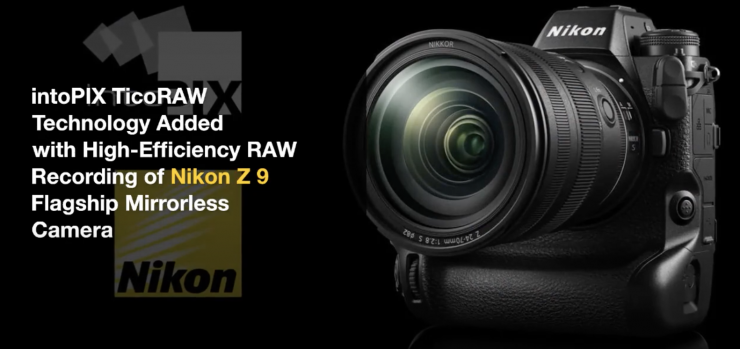
Here is what intoPIX officially said in December last year: The new Z 9 camera offers High-Efficiency RAW recording up to 8K and 60fps (available through the 2022 firmware update), preserving all the benefits of the RAW format, while ensuring very low power processing and very fast transfer speed.
With TicoRAW, the full quality of the captured sensor data is preserved while reducing the bandwidth and the storage needs. It can be used for both Still pictures and RAW movies. This patented technology offers high image quality, and the capability to manage very high resolutions, high frame rates and high dynamic range workflows. TicoRAW is the world’s first RAW codec that can offer compression efficiency with such low complexity. It also has the advantage of retaining this very fast format for editing, regardless of resolution and/or frame rates used.
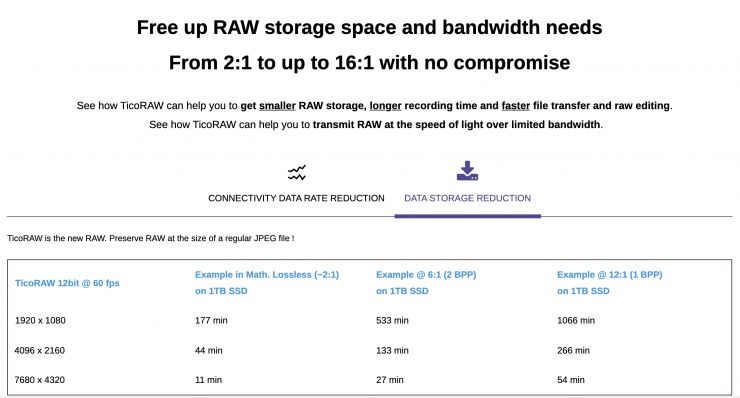
Above you can see how much recording time you can get on a 1TB card/SSD if you were recording TicoRAW 12-bit at 60fps. There appear to be three versions of Tico RAW with varying compression values. I imagine that Nikon is able to offer internal RAW recording in the Z8 and Z9 because intoPIX has its own patent for TicoRAW that presumably allows it to circumnavigate RED’s patent.
Now, in saying that, RED did take Nikon to court, but that case was dismissed just recently.
The RED.com LLC lawsuit against Nikon was over what they state is an infringement of their Video Compression Patent that Nikon introduced in the 2.0 firmware update for the Z9 camera. With the 2.0 update, the Z9 can capture 8.3K RAW video at up to 60 frames per second in Nikon’s new “N-RAW format” or up to 4.1K at 60 frames per second ProRes RAW HQ.
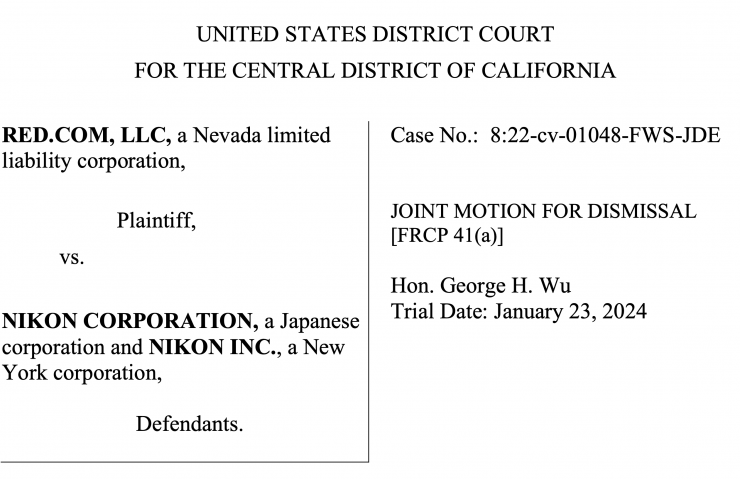
Well, that lawsuit has been dismissed. Now, we have no idea what actually happened, but here is the dismissal:
Plaintiff Red.com, LLC and Defendants Nikon Corporation and Nikon Inc. hereby stipulate and move pursuant to this joint motion, under Federal Rule of Civil Procedure 41(a)(1)(ii), that this action be dismissed without prejudice as to all claims, counterclaims, causes of action, defenses, and parties, with each party bearing their own attorney’s fees and costs.
A case dismissed with prejudice is completely finished and it can’t be brought back to court again. A case dismissed without prejudice means the exact opposite. Essentially it can be tried again.
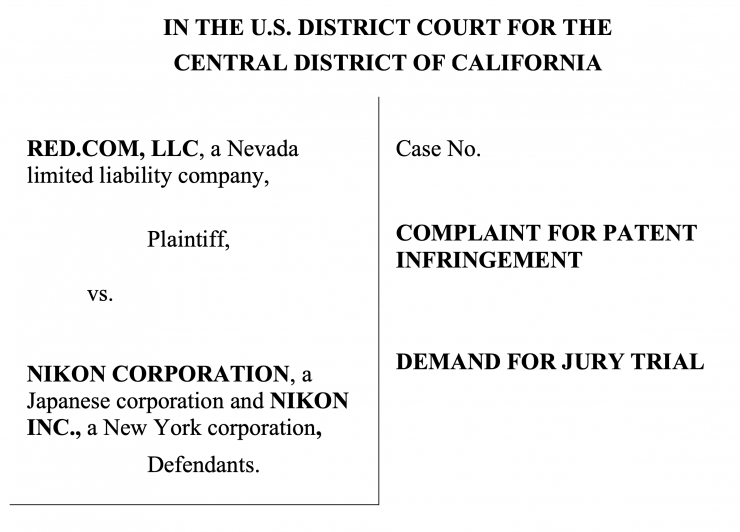
The lawsuit never made it to a jury trial.
Essentially neither side won, as a joint motion from both Red and Nikon was filed to dismiss the lawsuit. What that means is anyone’s guess. Nikon may have settled out of court, Red and Nikon may have both got to a point where neither party was confident of winning, or Red possibly felt that because Nikon doesn’t make digital cinema cameras, it wasn’t going to hurt them directly. This is all just speculation and the only ones who know for sure are Red and Nikon.
Nikon hasn’t released any statement, nor have they issued any type of firmware update that removes internal RAW recording from the Z9. With the Z8 having the ability to record internal RAW the settlement there was either a monetary licensing settlement done or RED felt that it wasn’t worth pursuing.
What is interesting is that just one week prior to the dismissal a joint stipulated motion to extend discovery deadlines and extend the jury trial date was denied by the court.
What was the Lawsuit
The lawsuit has stated several allegations of the use of REDs patent. Below is the main concerns.
29. RED is informed and believes and thereupon alleges that Nikon makes, uses, imports, offers to sell, and/or sells in the United States, and in this judicial district, cameras under the Nikon brand that infringe each of the asserted patents.
30. RED is informed and believes and thereupon alleges that Nikon’s infringing video cameras (the “accused products”) include, but are not limited to, “Z Series Mirrorless Cameras” such as “Nikon Z 9 with Firmware 2.0.”
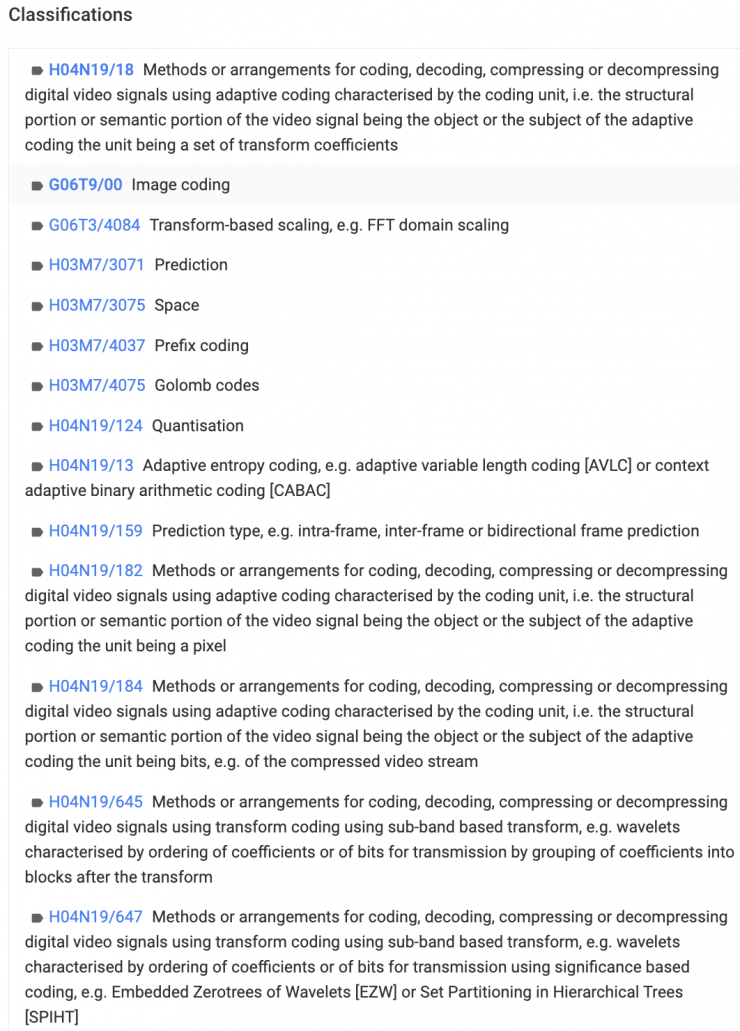
Above you can see the classifications for the patent. If you want to see and read the full details of the patent you can here.
So how do you deal with N-RAW?
Here is where things get a little tricky as there aren’t many options for dealing with N-RAW. DaVinci Resolve is the program you need to use.

In DaVinci Resolve you can see your N-RAW clips as well as the MP4 proxies.
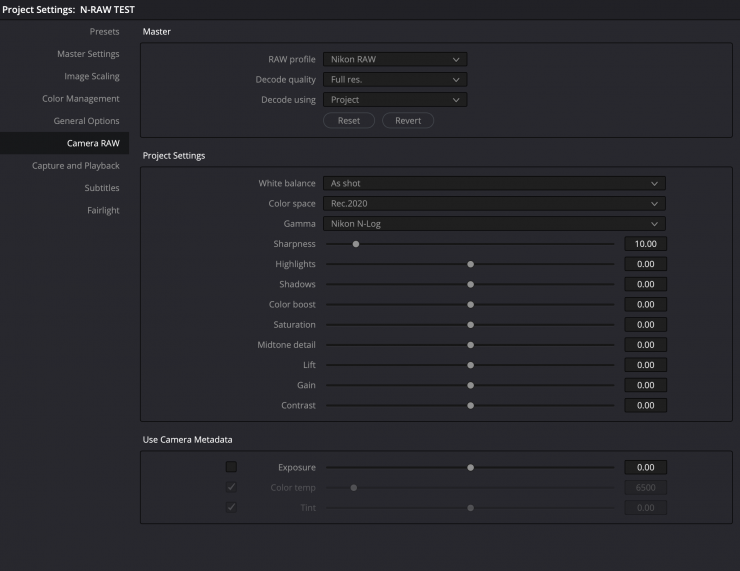
In your Project Settings, you can set your camera RAW to Nikon RAW (N-RAW) and you can see what adjustments are available for you to use.
On the color page, you can also change these parameters if you don’t want to do it earlier. What you will notice is there is no way of adjusting your ISO in post with N-RAW. There is, however, an exposure slider that you can use to obtain a similar result as if there was an ISO adjustment. I actually don’t mind using the exposure slider because you can adjust it in very small increments whereas an ISO exposure only lets you make larger adjustments. Yes, a dedicated ISO slider would have made more sense, but its hardly a deal breaker.
You expose for N-RAW in exactly the same way as if you were shooting Log in H.655 or ProRes. In that respect, there is no real learning curve if you haven’t shot RAW before and are a little bit worried about trying it out. Just expose as you would when you are shooting Log and you will be fine.
There is no magical increase in dynamic range when shooting in RAW and nor should there be. No camera has more dynamic range when shooting in RAW as opposed to Log.
N-RAW material behaves in a very similar way to most RAW formats and it is reasonably easy to make adjustments to your images. Some people have the misconceived opinion that they need to shoot in RAW when most people actually don’t. If you shoot in a good quality codec and you get exposure and white balance in the ballpark then there are no massive advantages to shooting in RAW.
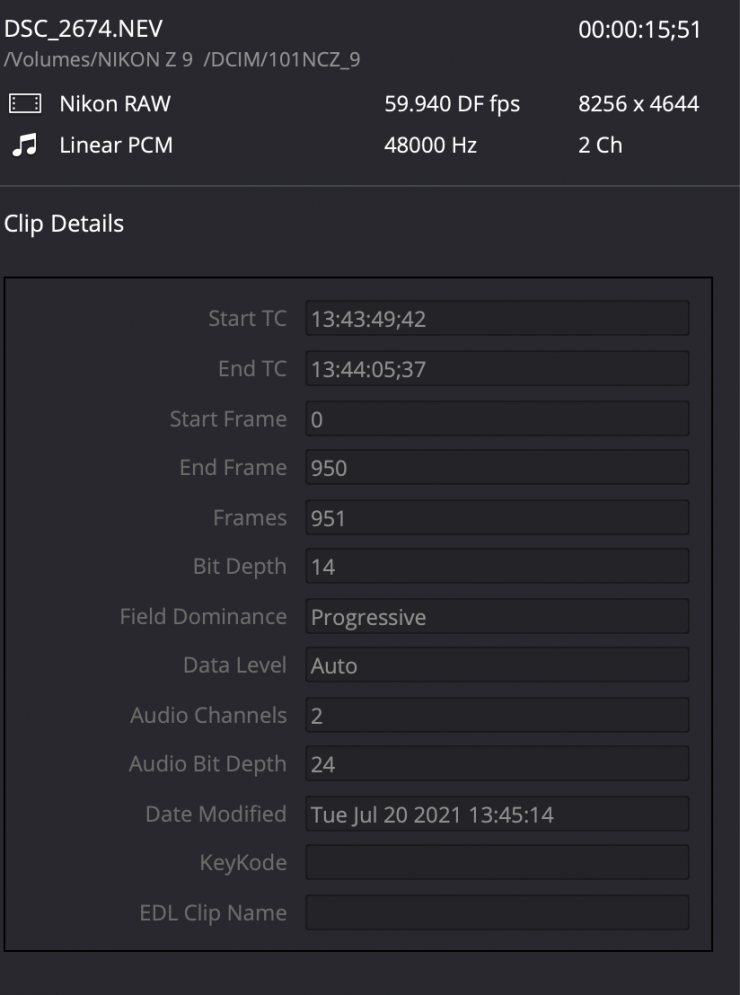
As I previously mentioned you can shoot N-RAW in 8256 x 4644 at up to 59.94p.
As a test above is an image captured in 8256 x 4644 59.94p at 800ISO. I have also included a shot of the waveform as well. This is a challenging scene because we have a very bright window and some very dark areas. We do have a tiny amount of clipping in the highlights and there is still information in shadows, although not a lot.
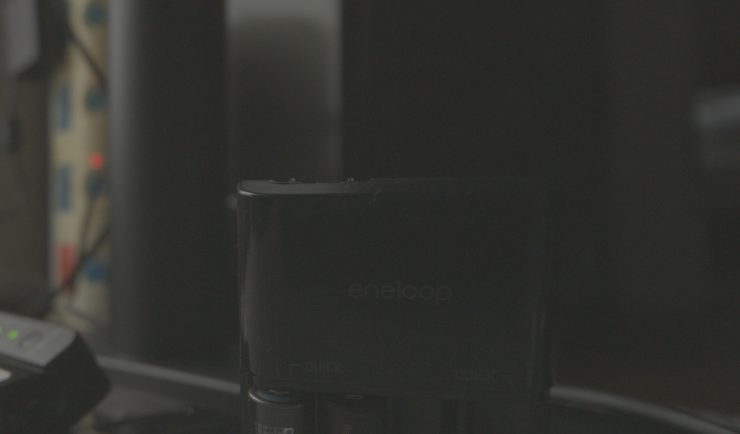
If we zoom into the image you can clearly see that there is noise in the shadows. Because of the aggressive nature of the N-Log curve, it tends to crush the shadows down to try and limit the noise. The problem with this is that you don’t get a lot of information to work with in the shadows.
The N-RAW material does respond well to noise reduction in DaVinci Resolve and you can certainly clean your image up. Above you can see that it wasn’t too hard to deal with this particular scene and you can push and pull the image around as you like to give it different looks as you see fit.
If you over-expose highlights you can’t use highlight recover in your RAW settings to bring anything back. Because the camera clips highlights quite aggressively, there is no information there that you can recover, even when shooting in N-RAW. You also don’t want to underexpose your image because that will result in quite a lot of noise being introduced into your images. The best advice I can give is to just try and expose correctly in the first place. RAW is not some magical fix where you can incorrectly expose your images and just assume you can fix everything in post.
You can still shoot in N-RAW and instead of selecting N-Log as your gamma you could choose linear instead and then do a color space transform and change it to something else.
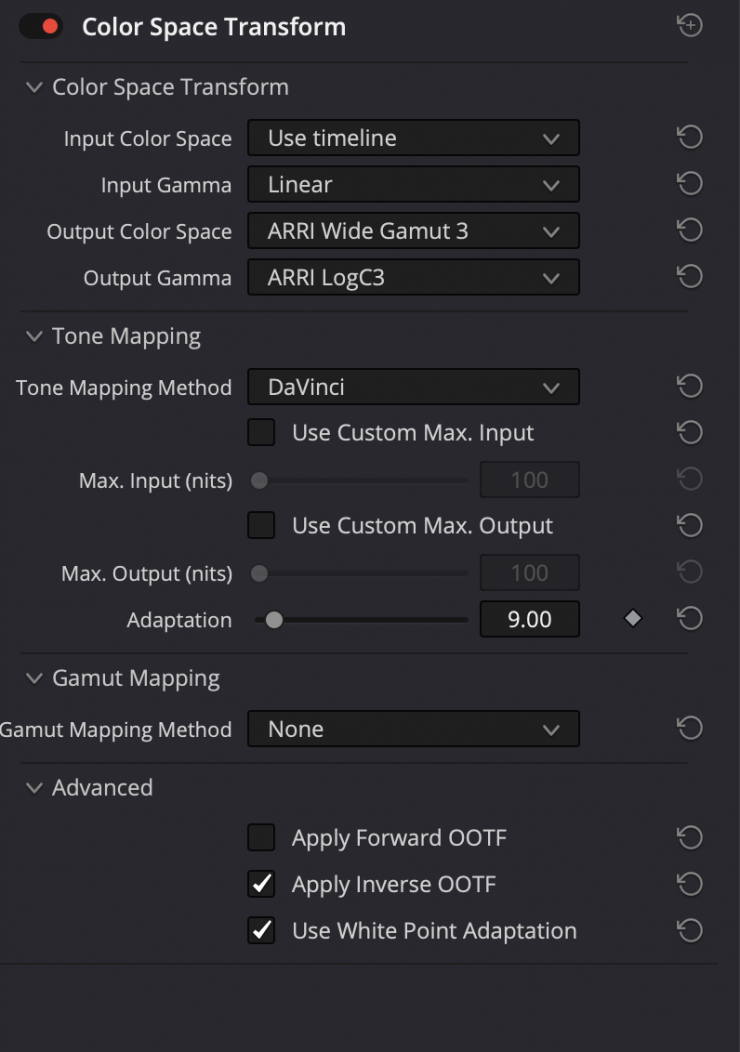
Why would you want to do this? That is a good question. You are not going to magically get better dynamic range, but what will happen is that the tonal values of your image will be distributed differently. What I found when using the Z9 is that it tends to crush the shadows quite a lot and if you underexpose your image you end up with a ton of noise. So will changing the gamma to linear and doing a color space transform help?
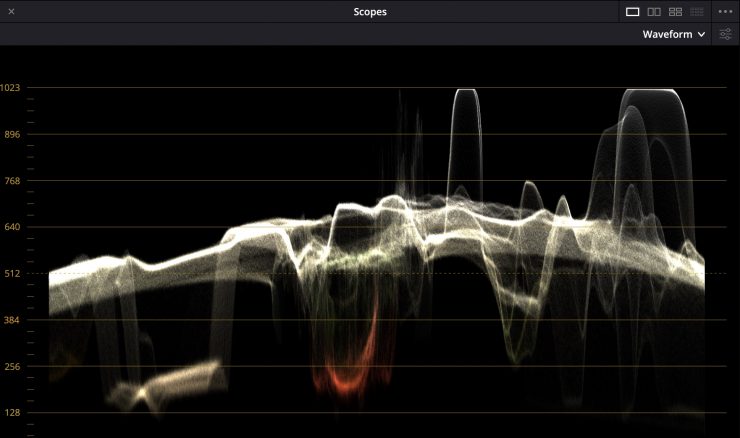
N-Log Gamma 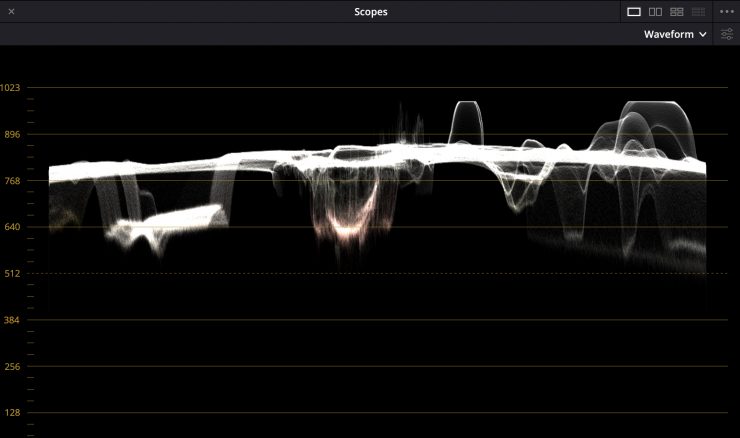
ARRI LogC3
Above you can see that the distribution of the tonal values changes dramatically if you choose Linear instead of N-Log as the gamma and then do a color space transform to use ARRI LogC3. While this can work, it does introduce extra steps and I don’t honestly feel that you gaining that much by doing this.
You also have to be very careful when using this method because depending on the type of shot you have you can introduce a ton of noise and you can end up hard clipping highlights. If the lighting in your shot is fairly even then it works well, but if you shoot a very contrasty scene you can run into big issues. The safety net behind all of this is you don’t have to use one particular method. Changing the gamma to linear might work for some things and not for others. How you process the RAW images is entirely up to you.
Above is a clear example of what can happen if you change the gamma to linear and then do a color space transform to say ARRI LogC3. Look what just happened to my image. I can’t recover this image. When I tried setting the output gamma to Panasonic V-Log and the output color space to Panasonic V-Gamut I did get an image I could work with but it required a lot of steps to fix it. It was a similar story if I set the output color space to Sony S-Gamut3.Cine and the output gamma to Sony S-Log3.
You need to be very careful when setting the gamma to Linear on the Z9 and then doing a color space transform as you can get very mixed results.
I am also not a fan of the N-Log LUT that Nikon provides. It is way too overly saturated and extremely contrasty. Using this method of changing the gamma to linear and then doing a color space transform seems to yield pretty decent results and you could use this as an alternative method of dealing with the N-RAW material.
The RAW images, like all RAW images, will be noisier than their Log or baked-in picture profile counterparts. Do I personally see any big advantage in shooting in N-RAW? Not really, unless you want to capture in 8K because you can’t shoot 8K ProRes. RAW does over increased flexibility in post, but it is also a lot more effort and work and ultimately I don’t think you get far superior results as opposed to shooting in Log.

Asa side note, if you use Nikon’s NX Studio software you can see the MP4 proxies that are created, but you can’t view or process the N-RAW images.
ProRes RAW
The Z8 is just the second camera to be able to shoot ProRes RAW internally. ProRes RAW HQ can be done in the following resolutions, frame rates, and image areas:
Full Frame/FX Mode
- 4.1K 60p
- 4.1K 50p
- 4.1K 30p
- 4.1K 25p
- 4.1K 23.98p
1.5x DX Crop
- 5.4K 30p
- 5.4K 25p
- 5.4K 23.98p
2.3x DX Crop
- 4K UHD 60p
- 4K UHD 50p
Just like with N-RAW you have the choice of two-tone modes: SDR and N-Log.
A 1TB card will allow you to shoot 28 minutes of 4.1K 60p ProRes RAW HQ footage. If you switch to the 1.5x DX mode and shoot 5.4K 23.98p you can record for 42 minutes.
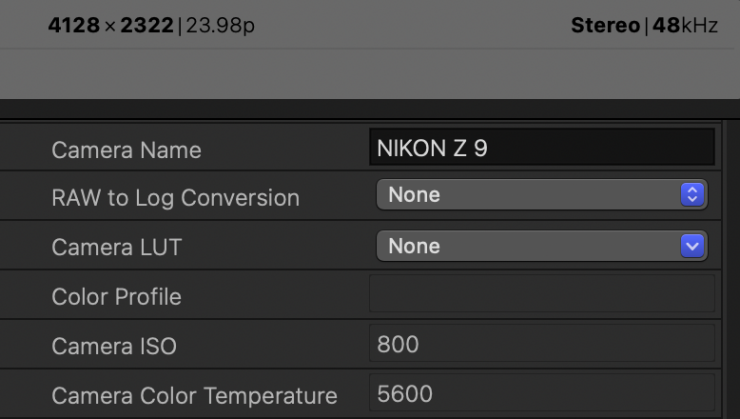
Final Cut Pro does see and let you use ProRes RAW files from the Z9. If you don’t have version 10.6.3 you won’t see options to change the ISO and white balalnce.
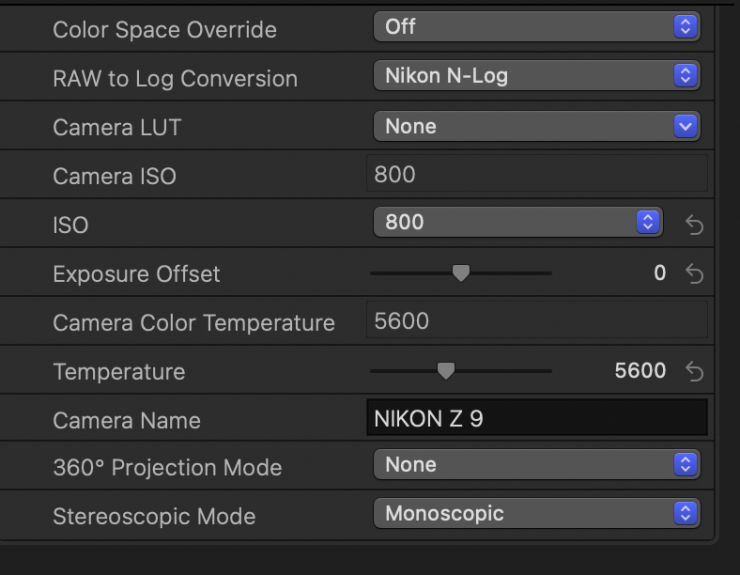
Camera ISO and white balance are both listed in Final Cut Pro version 10.6.3, and you can make changes to both of those values. You can only do this by going to the Information tab and then selecting Settings.
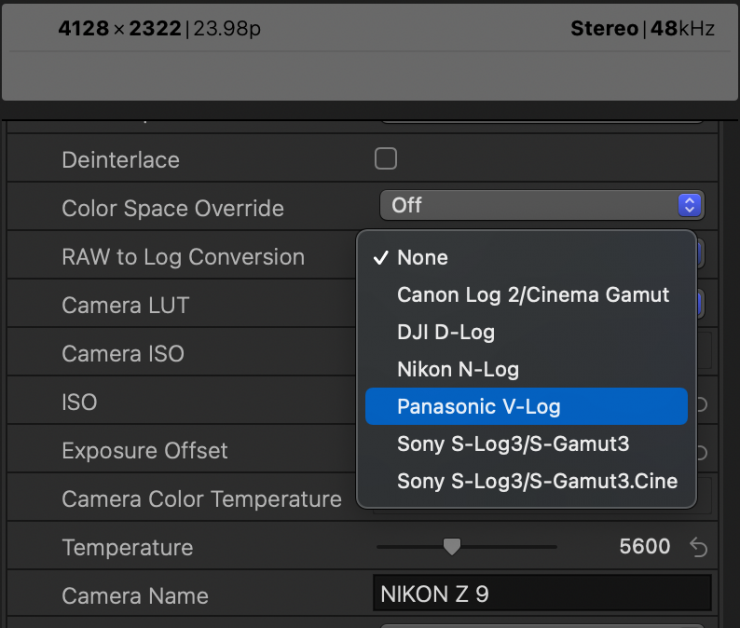
Now, with ProRes RAW files from the Nikon if you prefer to change the RAW to Log Conversion to something other than Nikon N-Log you don’t actually get a ton of options.
You can choose to apply any camera LUT you want regardless of what RAW to LOG Conversion you choose. Sticking with N-Log as the RAW to LOG Conversion and then just choosing the Nikon N-Log LUT provides pretty good results straight out of the box.
The ProRes RAW files are easy to work with and they provide good results.
Caveats when shooting in RAW
Shooting in RAW, either N-RAW or ProRes RAW does have some caveats that you need to be aware of:
- The display zoom cannot be used while video is being recorded in RAW. You can use display zoom when you are not recording, but once you hit record that is no longer possible.
- ISO 800-25,600 are available
- Diffraction Compensation won’t work with lenses
- Electronic VR is disabled
- Regardless of the option you select for HDMI Output Resolution when shooting in N-RAW or ProRes RAW, the maximum output resolution is 1920×1080
What about the heat?
Full frame mirrorless cameras recording high resolution and high frame rate video generate a lot of heat. Unlike digital cinema cameras that have large cooling systems and vents to dissipate the heat, most mirrorless cameras are weather sealed. This means that there is nowhere for the heat to escape. As a result, a lot of full-frame mirrorless cameras suffer from overheating problems when they are recording video.
The Z8 doesn’t feature any type of fan like the Panasonic S1H, Canon R5C, or Panasonic GH6.
One of the biggest selling points of the Z8 is that Nikon states that the camera can continually record without any overheating issues.
The Nikon Z8 does have a Memory Card High-Temperature Warning that can come on when capturing video. If the memory cards become too hot a high-temperature warning will appear in the shooting display. Nikon recommends that you do not attempt to remove the memory card; instead,
wait for the camera to cool and the warning to clear from the display.
I think it is fair to say that some current and previous cameras have had recording limitations artificially imposed that purposely limited their capabilities, mainly because of market segmentation. If you are offering several models at different price points then the manufacturer will inevitably not include, or limit some forms of functionality in the camera. Any manufacturer has the right to do this. Whether a camera can do more than it is actually capable of is irrelevant. If a manufacturer chooses to limit the capabilities or performance of a camera that is their choice. As a consumer, you may not be happy about this, but nobody forces anyone to buy a camera. If you don’t like what a certain manufacturer has done then don’t give them your money.
ISO when working in various modes
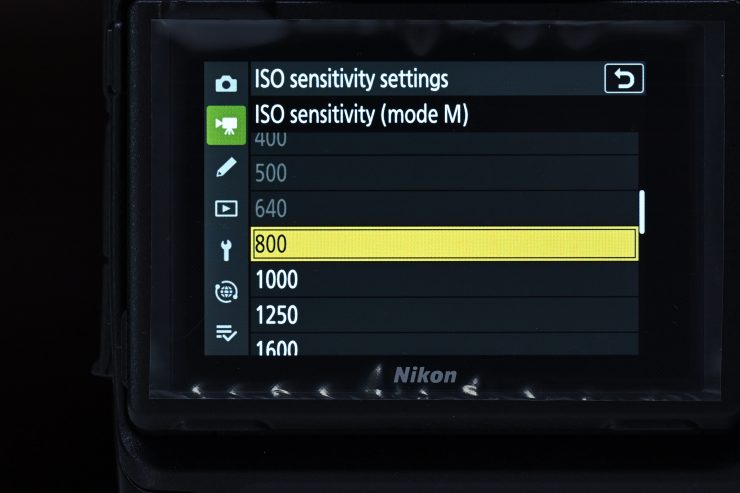
The ISO values in the Z8 do change depending on what profile you are shooting in:
[N-Log ProRes]
Base ISO 800 (Available ISO options: 400-25,600) HI 0.3/0.7/1.0/2.0 are not available when shooting in N-Log.
[N-Log H.265]
Base ISO 800 (Available ISO options: 64-25,600) HI 0.3/0.7/1.0/2.0 are not available when shooting in N-Log.
[Hybrid Log Gamma H.265]
Base ISO 800 (Available ISO options: 400-25,600) HI 0.3/0.7/1.0/2.0 are not available when shooting in N-Log.
[Other Picture Profiles]
Base ISO 800 (Available ISO options: 64-25,600 and HI 0.3/0.7/1.0/2.0
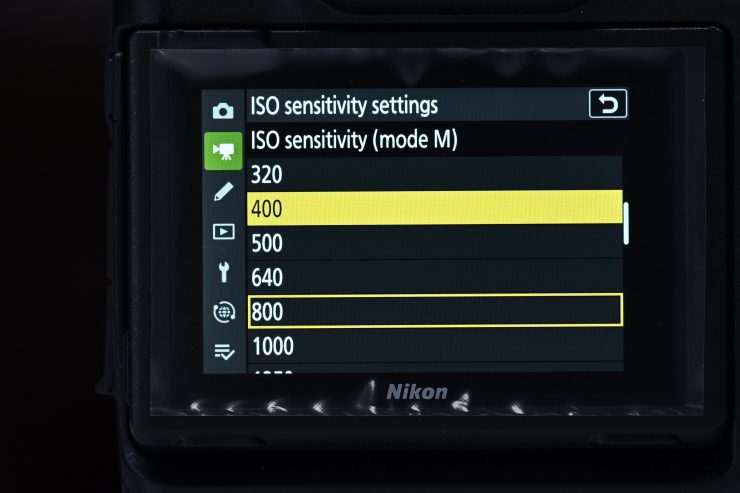
What is nice is that Nikon clearly lists the native base ISO values depending on what profile you are shooting in. It is always highlighted with a box, in the menu options. Even if you are in a mode where you can go below 800, 800 will always be clearly shown.
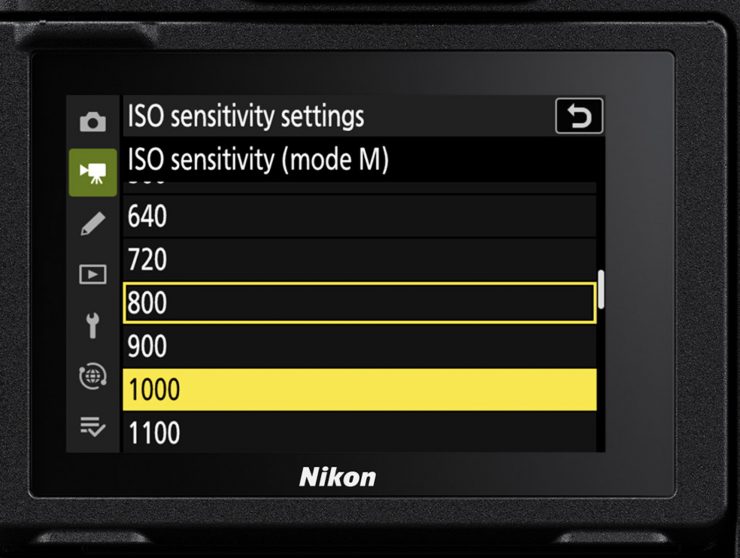
There is a Fine ISO control (Mode M) mode that enables exposure adjustments in increments of 1/6 EV. This is quite interesting because you can select ISO settings that you wouldn’t traditionally find on cameras.
N-Log

The Nikon Z8 allows you to shoot in N-Log. N-Log is Nikon’s Log curve and it was introduced with the Z6 and Z7.

Above you can see the Gamut and white point for N-Log. The white point of N-Log is D65. The gamut for N-Log is the same as the wide color gamut known as “ITU-R BT.2020”.
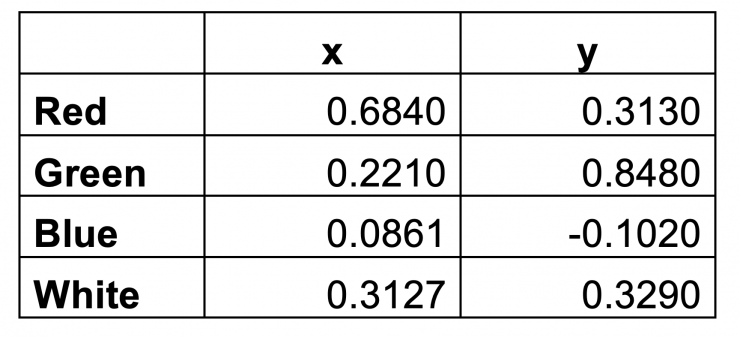
As a comparison above you can see the same information for ARRI’s C-Log.
You can only shoot N-Log when recording ProRes or H.265 4:2:2 10-bit. It isn’t available if you shoot H.265 4:2:0 8-bit. I am glad Nikon didn’t enable N-Log for an 8-bit codec.

It is a little difficult to find N-Log as it isn’t listed in the Picture Control settings. You can only find it when you go to the Video File Type menu and then select Tone Mode.
If you select N-Log you can’t change any parameters such as sharpness, etc.
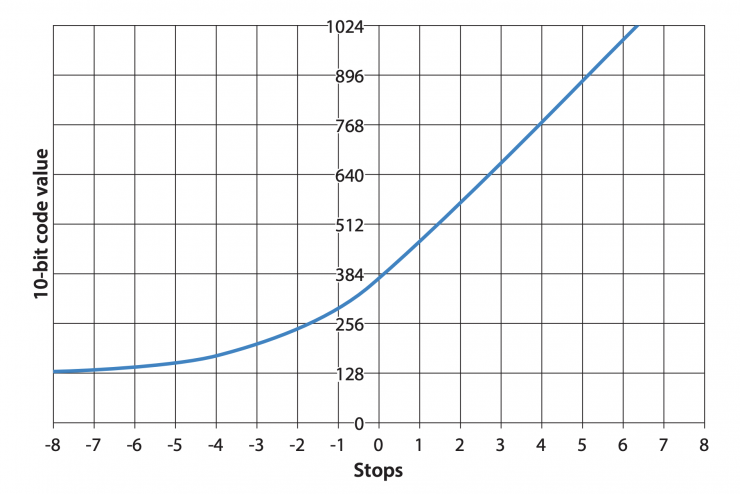
The biggest issue with N-Log is that it was only designed to capture up to 12 stops of dynamic range from the camera’s image sensor. It was designed for the Z6 and Z7 and in my opinion, it really needs to be updated to work correctly with the Z8 & Z9.
If you do select N-Log you can activate a View Assist in the menu. What you need to be very aware of is there is no option to turn this on or off on the signal going over HDMI. The signal going out over HDMI is displayed as N-Log and the View Assist isn’t applied to the output. This means you need to add or use a LUT on an external monitor.
The other real-world issue with N-Log is that if you use View Assist it doesn’t in any way reflect what the N-Log LUT looks like. If you expose based on what looks correct on the LCD screen or EVF you will quickly find that your N-Log image is underexposed. The last thing you want to do when shooting N-Log is to underexpose because the N-Log curve certainly doesn’t give you much headroom in the shadows. Underexposing leads to severe image noise in the mids and shadows if you need to lift them up.
I was puzzled as to why Nikon thought it was ok to have a Log curve and not be able to monitor that Log curve correctly in-camera.
Other things to be aware of are that Set Picture Control and High ISO NR are not available in the video recording menu when shooting in N-Log.
The Active D-Lighting item in the video recording menu is also set to Off and cannot be changed.
Now Nikon also states that ‘The camera may have trouble focusing using autofocus but this does not indicate a malfunction.’ I didn’t notice any huge difference with the AF performance when shooting in N-Log.
LUTs
There is no way of loading up or using LUTs on the Z8. This is a big oversight specifically since Nikon recently released a new N-Log LUT that was claimed to be specifically developed for the Z8. To be honest, I couldn’t tell the difference between this LUT and the LUT that was made available for the Z6/Z&II, and the Z7/Z7II.
Not being able to load up LUTs on a flagship mirrorless hybrid camera that has impressive video specifications is a bit of a head-scratcher.
You can download the Nikon Z9 N-Log LUT here. I am not sure how this LUT differs from the previous LUT that was available, to my eye it looks identical.
What does it record to?
The Z8 features 1x CFexpress Type B / XQD and 1x SD/SDHC/SDXC (UHS-II) card slots. Yes, I can understand the rationale for having one CFexpress and one SD card slot, however, I would much prefer to have the ability to be able to record any resolution, frame rate, and codec to both cards without having to worry about which one to use. SD cards are a lot more affordable, but they are old technology and CFexpress cards are so much faster when offloading your material. If you are shooting video this makes a huge difference.
There is a menu setting that shows you how much remaining time is on your cards. You can toggle between the cards to select which one you want to use for recording.
You can select how the dual card slots work, however, you can only do this for stills. Nikon hasn’t put any options in the Z8 for allocating how a dual card set-up works when recording video. You don’t seem to be able to dual record to two cards at once, nor can you record a different resolution or codec to another card at the same time. This is something you can do with the Canon R5 C.
Two USB-C Ports
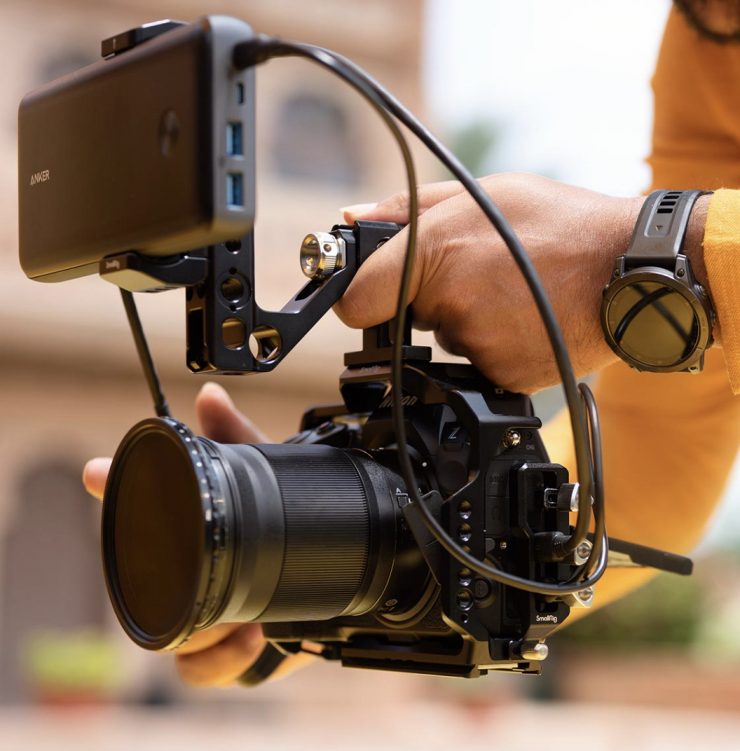
There is one USB data connector (SuperSpeed USB) for file transfers and connecting accessories, and another dedicated for charging and providing constant power.
What can it output over HDMI?
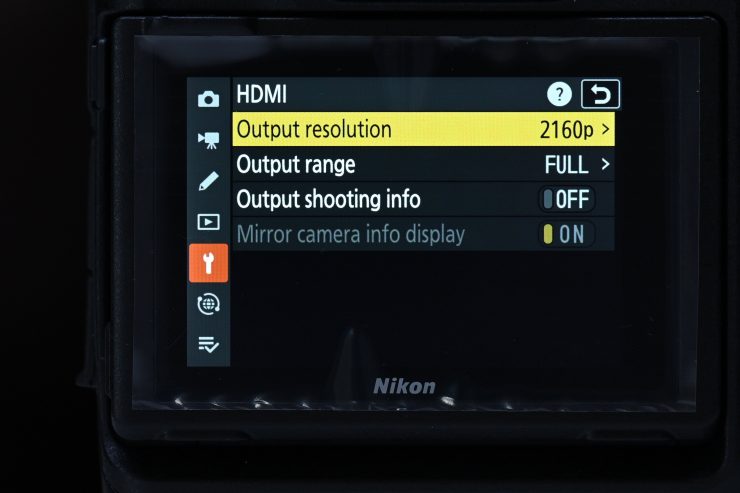
The Z8 has a few options when outputting over HDMI. You can change the resolution, output range and turn your camera’s info display output over HDMI On/Off.
What you clearly need to be aware of with the Z8 is that the output resolution changes depending on whether you are externally recording, just monitoring, or if you have memory cards in the camera.
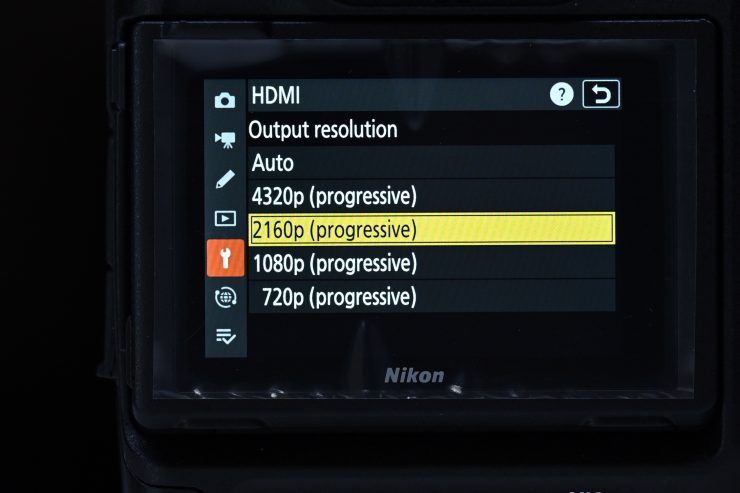
Over HDMI you can currently output up to 8K 30p.
When Auto is selected for HDMI Output resolution in the setup menu, the camera automatically detects whether the external recorder supports the frame size and rate selected on the camera. If it does not, the camera will search for a supported resolution and frame rate in the order listed below in the table. If no supported resolution and frame rate is found, the output will be suspended.
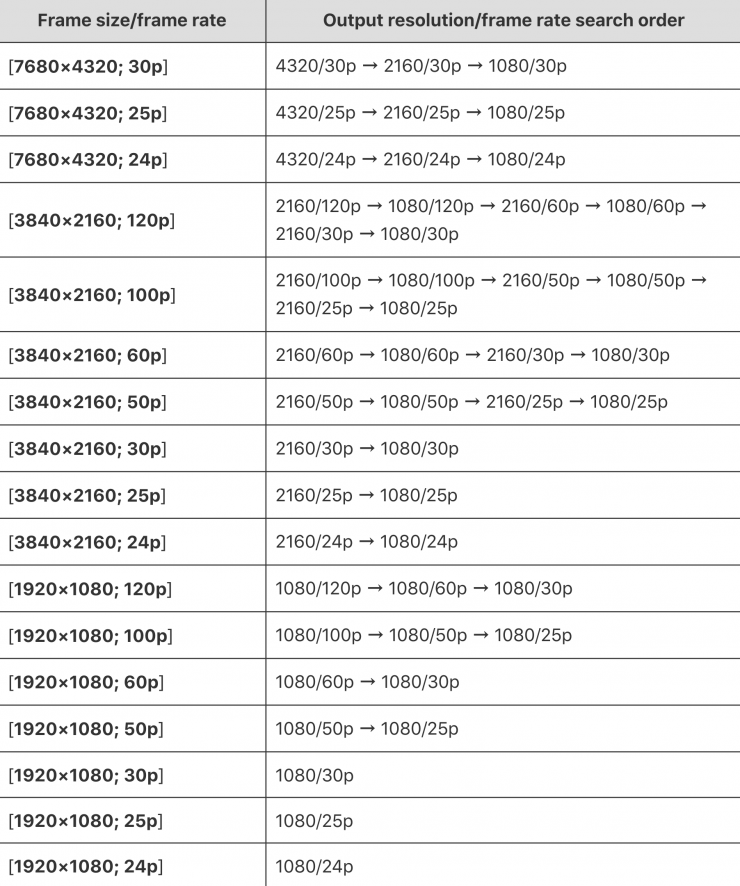
Above you can see what the Z8 can output over HDMI when no memory cards are in the camera. You can output frame rates of up to 30p in 8K, 120p in 4K DCI or UHD, and up to 120p in HD.
In Version 2.0 firmware Nikon added a 1080i (interlaced)] option under the HDMI Output Resolution. This is handy if you happened to be using the Z9 for a live shot in a news environment and you were required to output an interlaced image.
Autofocus
According to Nikon, the Z8 features advanced AF performance and ultra-high-speed shooting. The camera can track people, dogs, cats, birds, bicycles, motorcycles, cars, trains, and airplanes. What is nice is that the camera is intelligent enough that if you set the subject detection to auto, it will automatically select the correct tracking without you having to go into a menu and choose it.
Covering the full sensor area, the Z8 uses a 493-point phase-detection AF system to realize fast and accurate focusing performance. This system is benefitted by the high-speed communication of the Z interface along with the speed of the sensor that enables AF readings to occur at up to 120 fps. This focusing system also supports working in low-light conditions with a Starlight mode that permits focusing down to -8.5 EV to greatly benefit astrophotography, concert, and other nighttime shooting applications.
Lens Mount
The Z8 uses Nikon’s Z-Mount which has a very short flange distance. The system’s large lens mount features a 55mm inner diameter and short 16mm flange focal distance which allows for a lot of flexibility in the optical design of NIKKOR Z lenses. This allows Nikon to create lenses with maximum apertures as wide as f/0.95.
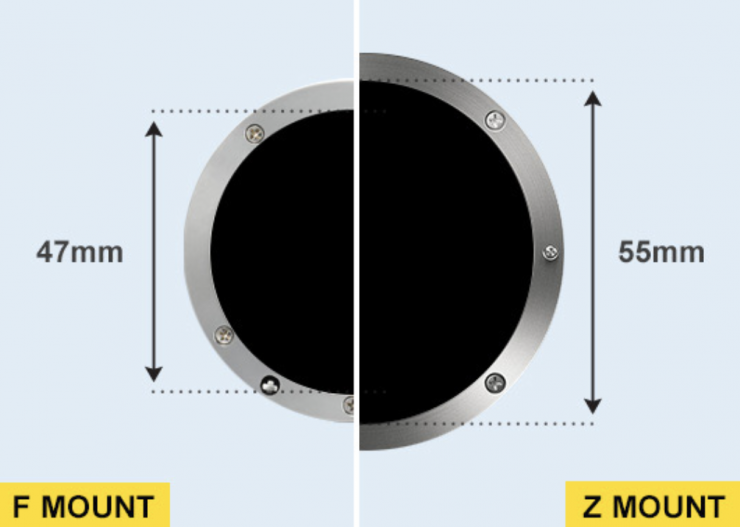
The internal diameter of the Z mount is 17% larger than the Nikon F mount. I believe it is still currently wider than any full-frame mount available in a mirrorless hybrid.
By creating a mount with a large inner diameter and short flange focal distance, compact lenses can be designed that allow more light in.
Having a short flange focal distance allows you to use a wide variety of lenses through adapters. In saying that, you can do the exact same thing with canon’s RF mount, Sony’s E-mount, and Panasonic/Leica’s L-mount.
Lens choice and lens options are a big reason why shooters choose a particular system over another. This is especially true if you are selling cameras with good autofocus performance.
While a good proportion of mirrorless hybrid owners are using autofocus lenses, there are also quite a few users who prefer to run manual focus lenses and even PL cine glass on their cameras. This was the case with the S1H. Most users of that camera who were shooting professional video weren’t using AF lenses, instead, they were using manual focus stills lenses or PL glass with adapters.
Nikon makes some very good Z Mount glass and you can adapt older Nikon DSLR lenses through Nikon’s own FTZ II Mount Adapter. Why Nikon hasn’t made its own ND filter adapter like Canon is a mystery.
The problem for potential Z8 buyers is that unless you already own Z Mount glass I don’t see too many people running out and purchasing the camera. If you aren’t interested in AF or using AF lenses then the Z8 is certainly worth looking at, but if AF and AF capable lenses are part of your requirements by the time you buy a few lenses and the Z8 you are going to easily top $10K USD.
As Nikon wasn’t part of the conversation when it came to video-centric mirrorless hybrids for such a long time, a lot of shooters have already invested in systems from Canon, Sony, and Panasonic.
| PRICE | |
| Nikon NIKKOR Z 14-24mm f/2.8 S | $2,396.95 USD |
| Nikon NIKKOR Z 28-75mm f/2.8 | $996.95 USD |
| Nikon NIKKOR Z 24-120mm f/4 S | $1,096.95 USD |
| Nikon NIKKOR Z 24-70mm f/2.8 S | $2,296.95 USD |
| Nikon NIKKOR Z 70-200mm f/2.8 VR S | $2,596.95 USD |
| Nikon NIKKOR Z 400mm f/2.8 TC VR S | $13,996.95 USD |
| Nikon NIKKOR Z 50mm f/1.2 S | $2,096.95 USD |
| Nikon NIKKOR Z 85mm f/1.8 S | $796.95 USD |
| Nikon NIKKOR Z 58mm f/0.95 S Noct Lens | $7,996.95 USD |
Above you can see the price for some of Nikon’s Z-mount zooms and primes that are available.
Even though some of the Nikon lenses appear to be quite expensive, their prices don’t differentiate that much from similar options from Canon, Sony, and Panasonic
5-axis in-body VR & 2-axis lens VR
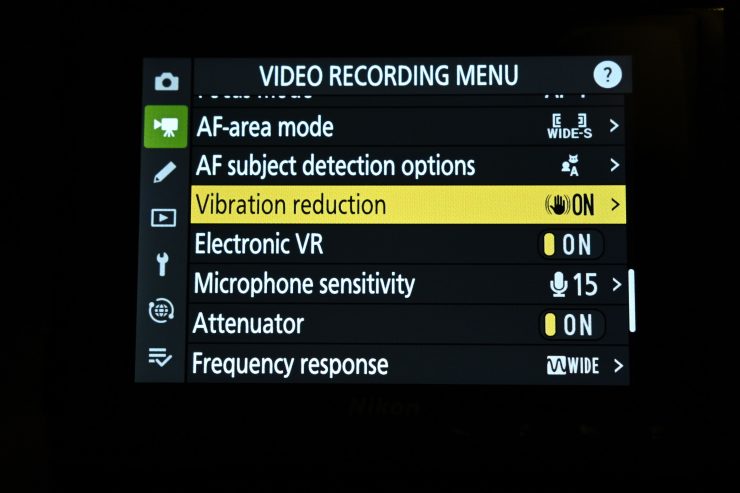
Nikon claims that the intelligence and processing power within EXPEED 7 improves electronic VR for video recording, correcting trapezoid distortion from wide angle lenses and allowing you to create smooth handheld walking shots.
The Z8 delivers advanced Vibration Reduction (VR) with Synchro VR where 5-axis in-body VR and 2-axis lens VR work together, achieving an effect equivalent to a shutter speed up to approx. 6.0 stops faster.
The Z8’s 5-axis in-body VR stabilization is very impressive, especially when used in conjunction with a lens that has VR capabilities.
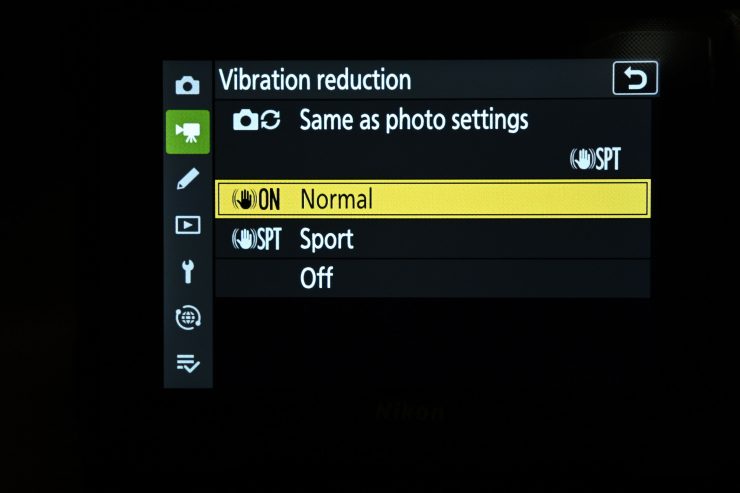
You can choose between Normal and Sport in the Vibration Reduction settings.
The combined stabilization works really well, it certainly allows you to capture very steady footage when shooting handheld. Above you can see an example where I had the Vibration Reduction turned on, the Electronic VR tuned on, and I was using a Nikon lens with stabilization.
Articulating Multi-Angle LCD Screen
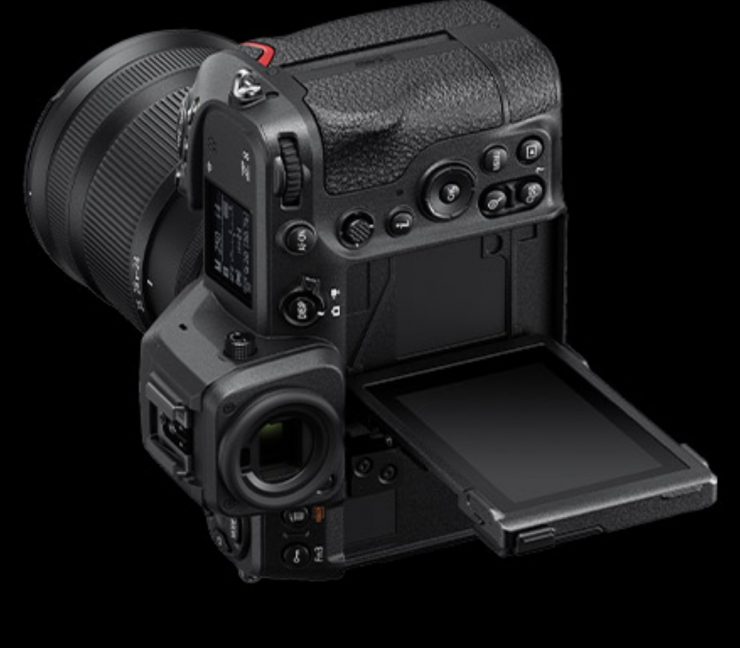
The Z8 comes with a fully articulating multi-angle screen. The four-axis tilting touchscreen LCD allows you to operate from high and low angles, regardless of shooting in the horizontal or vertical orientation. This screen’s four-way tilting design allows for easier viewing from a variety of positions and the user interface orientation will also shift depending on how the camera is held.
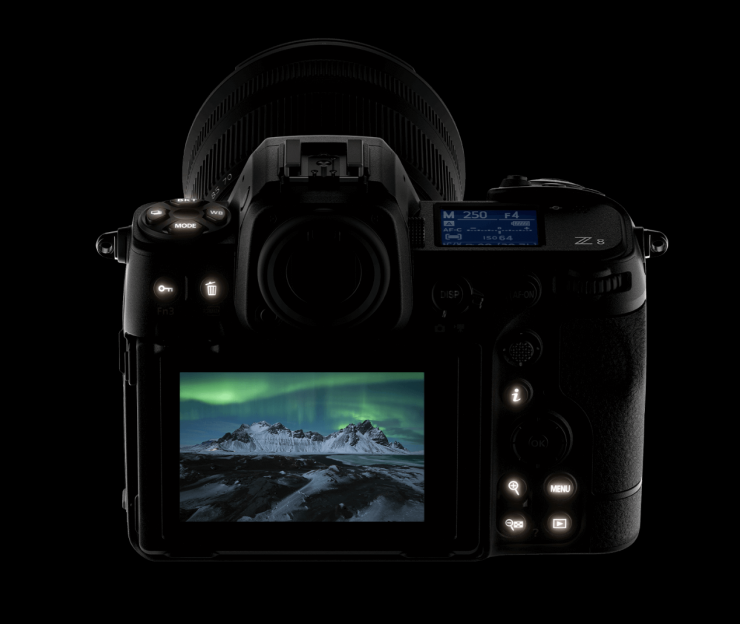
No, it doesn’t have a flippy screen, but I don’t think the target audience for this camera will be Vlogging or taking selfies.
EVF
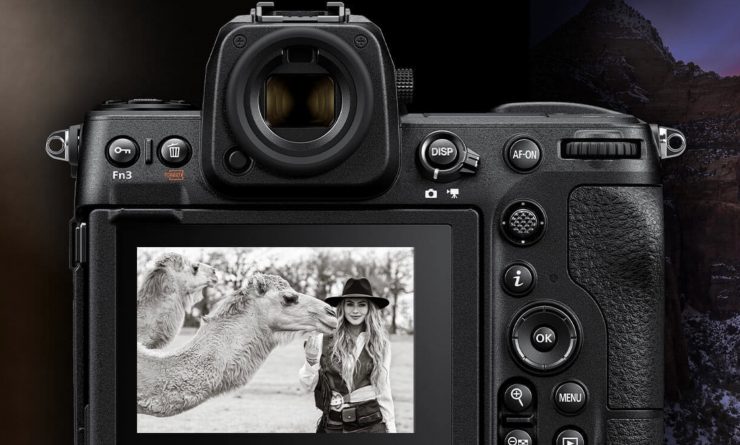
The camera has a Real-Live Viewfinder EVF that utilizes a quad-VGA panel with adjustable luminance up to 3000 cd/m2 for clear visibility in bright conditions. This EVF also works in conjunction with dual-stream technology for blackout-free viewing when shooting continuously.
The EVF isn’t going to be as good as what is on offer from some of the competition.
Audio
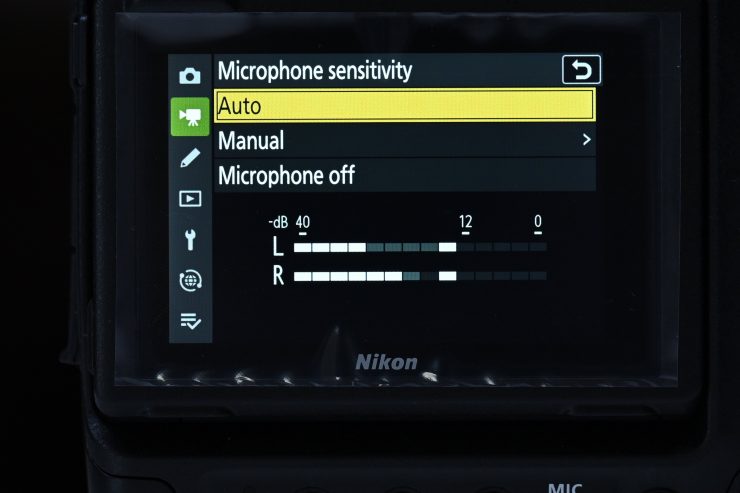
Good onboard audio recording is something that was rarely seen in mirrorless cameras, although it has started to get a lot better. It is good to see manufacturers paying more attention to audio, especially with more video-centric models. In saying that, the audio options on the Z8 are fairly basic compared to what some of the competition offers.
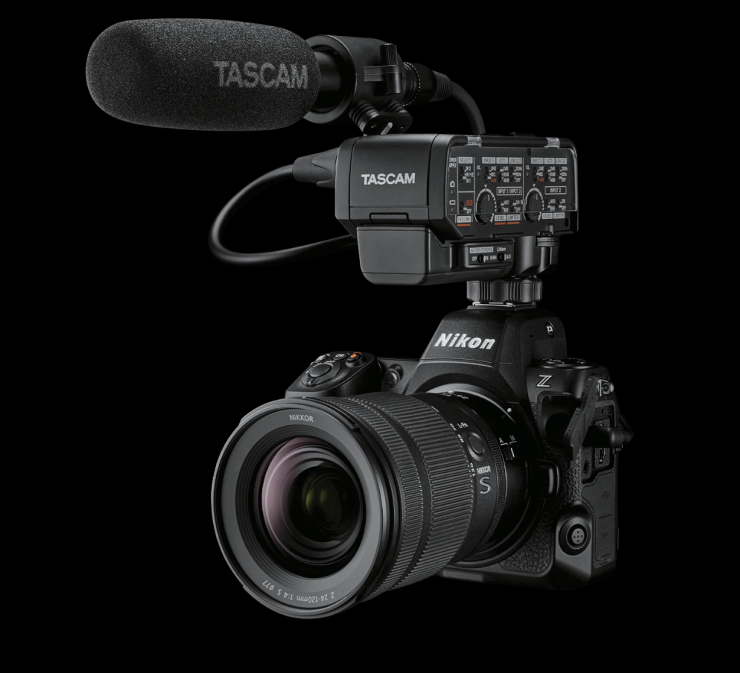
The Z8 does feature its own in-built stereo microphone and a 3.5mm mic input.
You can change the microphone sensitivity from Auto to Manual, however, if you choose manual you can only change the sensitivity from 1-20. While this is a reasonable amount of adjustment, Nikon doesn’t give you any indication of what 1-20 means.
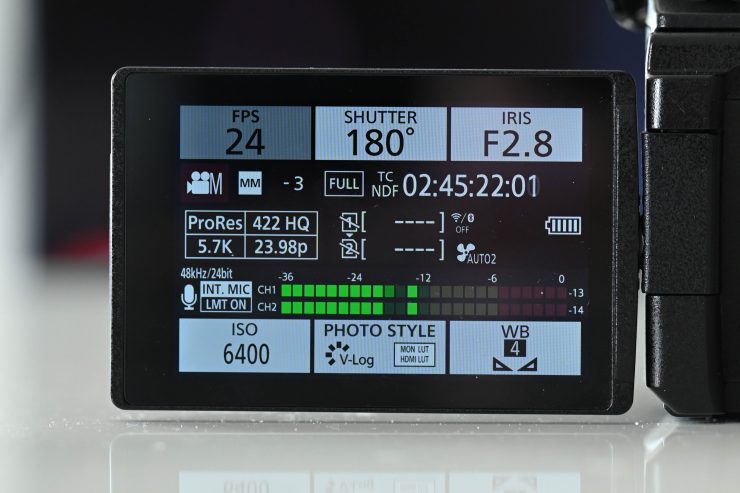
On video-centric mirrorless hybrids like the Panasonic S1H and GH6 you can set the input level to -18db and the audio meters get displayed as VU meters which makes a lot more sense.
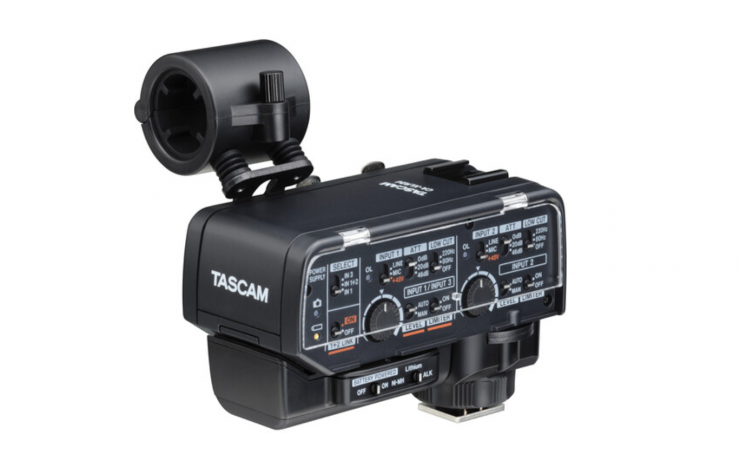
To get better audio capabilities you would need to pair the Z8 with something like the Tascam CA-XLR2d-AN XLR Microphone Adapter Kit for Cameras (3.5mm Analog) or a small-sized mixer/recorder. This would at least give you the ability to run two audio sources through XLR inputs, however, as far as I am aware you can’t record more than two channels of audio on the Z8.
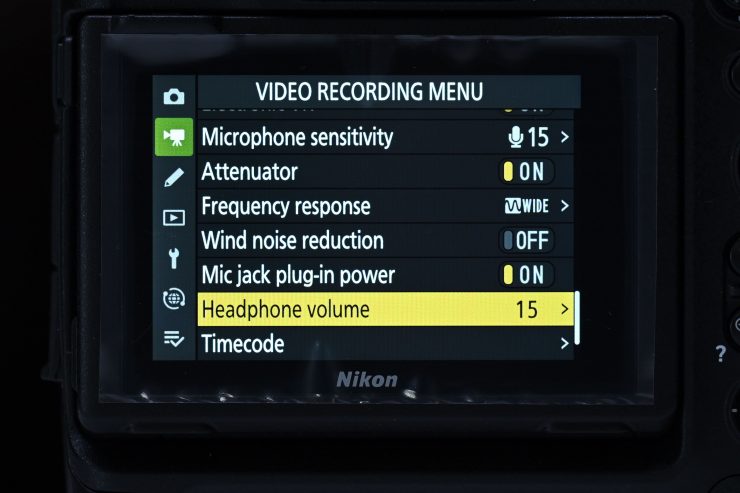
As far as headphone monitoring is concerned, you can adjust the level, but you can’t choose to listen to channel 1 or channel 2 if you are inputting a stereo source.
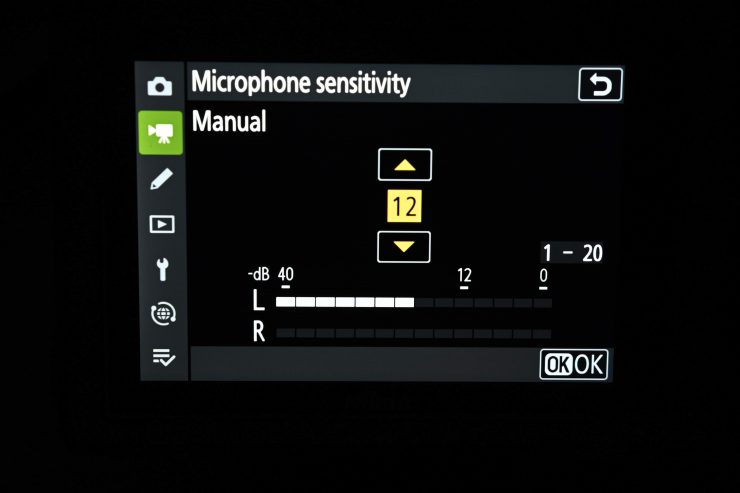
i Quick Menu
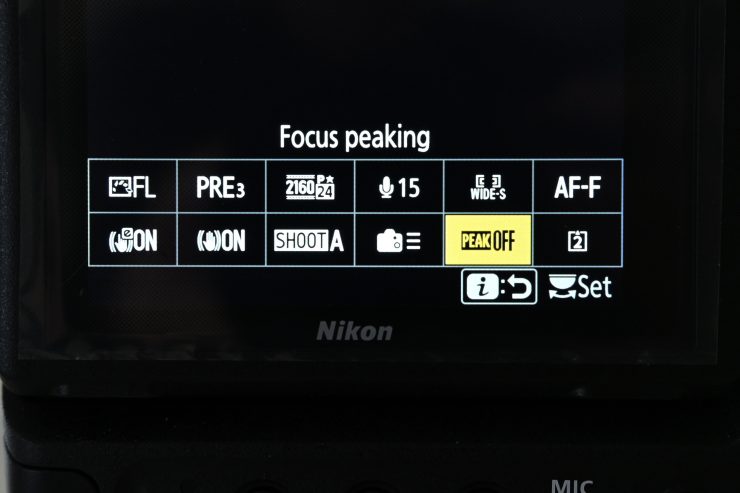
With the i quick menu option, you can easily and quickly make key parameter changes.
You can customize what is displayed on this screen for both video and stills.
Price & Availability
The Z8 retails for $3,996.95 USD.
How does this price compare to the other full-frame offerings from Panasonic, Sony, and Canon?
| PRICE | |
| Nikon Z9 | $5,496.95 USD |
| Panasonic S1H | $3,497 USD |
| Panasonic Lumix S5 II | $1,997.99 USD |
| Panasonic Lumix S5 II X | $2,197.99 USD |
| Canon EOS R5 | $3,399 USD |
| Canon R5 C | $4,399 USD |
| Canon EOS R3 | $5,499 USD |
| Sony a7R V | $3,898 USD |
| Sony a7 IV | $2,498 USD |
| Sony a1 | $6,498 USD |
The above prices are as listed on B&H as of the 10th May 2023.

